Nava Atlas's Blog, page 3
May 12, 2025
The Fox Woman by Nalbro Bartley (1928)
Journalist, short story writer, and lecturer Nalbro Isadora Bartley (1888 – 1952) published at least twenty-five novels between 1919 and 1934, sometimes releasing two in a year. The Fox Woman (1928) was her 19th novel.
At the start of The Fox Woman, whose cover blurb says, “The Fox Woman ever takes but never gives,” we are in the 1880s. Gender-neutrally-named “tomboy” Stanley is only seven but already her widowed father, Millard Ames, is in awe of her.
“There was something about Stanley that he could not gainsay— something so persuasive yet determined that he found himself yielding to her slightest request.” Stanley’s mother died in childbirth and her father has since dedicated himself to her, as his late wife’s friend Maggie has dedicated herself to him, though with no expectation of reciprocity.
“I love you, Millard. I’m content to serve you. I know I’m absurd when I try to think of romance. I’m not the sort men fall in love with.” Maggie Aydelotte, referred to by Stanley as Tante Aydelotte, is her “self-appointed overseer and secretary” and refers to Stanley as a “tiny fox woman,” in reference to the story of the (male but gender-fluid) Japanese fox god.
The fox god who changes himself into a beautiful woman and apparently comes to the rescue whenever trouble threatens or a boon is asked . . . but really, she is searching for thrills! It’s the best simile I’ve come upon for Stanley. The fox woman has a clever heart but the good she does never outweighs the evil she causes. She will bide her time to have her own way. Apparently she may be maligned, even self-sacrificing, but she turns events to her liking or else escapes from distasteful situations. She so dominates and maneuvers the lives of those about her yet remaining the innocent, misunderstood individual, that she escapes dénouements. Her aim is to have power—and to be amused . . .
From an early age, Stanley’s was “a masculine mind with keen feminine intuitions. Just as she reveled in beauty and was, herself, a thing of motion and loveliness, so she reveled in power, in any game of playing politics to bring about the desired result.” By the age of twelve, but looking fifteen, Stanley writes in her diary, “I have become a woman. My darling father does not realize this. I shall have him take me abroad — I do not believe that I wish an American husband.”
Her father dutifully takes Stanley to Paris, though his legal business is failing and he has little money; Tante has gone to the Midwest to become a teacher, having given up on marrying Millard Ames. Father and daughter stay in Paris until she really is fifteen and has still never been to school, but has “a proposal of marriage, a wealth of golden hair and the ability to execute fancy dances in a manner equal to that of a professional.
She had become a sparkling little cosmopolitan.” Having made sure that she would never have a second mother, Stanley “now focused her thoughts upon a husband. He must be handsome, rich, talented, and as devoted and deluded as her father who was to live with them for always. They must travel a great deal, and have a brownstone-front house in New York and perhaps a country place in the Berkshire towns.”
Stanley’s father dies when she is still fifteen and she wishes he had waited until she had found a husband but soon gets over him. “Stanley reordered her small world and was not unmindful that she looked well in black.”
Tante returns as Stanley’s guardian and tells her she must learn to live on very little money and attend her boarding school, Miss Masters’s Seminary for Young Ladies.
Bah, she hated the very thought of it—three years of namby-pamby monotony . . . yet she was penniless and only fifteen, quite alone save for this strangely loyal soul . . . she must make the best of it. One cannot always remain fifteen. And she had been born with the wisdom of fifty.
But Stanley hates the conformity of school; she is an individual not a conformist. “I won’t get-up early and eat scorched porridge and say prayers and walk and study and mend and scrub—I wish that I had eloped with anyone.”
What follows for the next few chapters of the long novel is a kind of bildungsroman of Stanley adapting herself to and then leaving school, trying to become an actress and becoming engaged to the besotted Blair Britton. And she continues to toy with Blair while juggling the attentions of the wealthy but much older and previously married Lee Van Zile.
All the time Stanley was playing a fascinating game of fox. She knew better than to surrender to Van Zile instanter—the ardent old chap had begged her to marry him three days after they met. To have caused another seven-day wonder in eloping with an elderly upstate millionaire and abandoning young Britton to heartbreak and drink would not have given Stanley the self-righteous thrill of victory she meant to obtain.
Stanley does, cruelly, foxily reject Blair and marry Van Zile, though she insists on him remodelling the gloomy old pile, the “red brick fortress,” where he lives. She soon comes to regret her decision, but understands it was inevitable given her true nature. “I had a greedy jewel-box instead of a flesh-and blood heart,” she tells Tante. But now Stanley is pregnant.
“I’m wondering if he’ll be like Lee, a monotonous little soul sure to get seven per cent on investments, or if he will be like me —cheating and selfish and covered with a veneer of smiles.” Tante realises that Stanley wants a son to have someone to dominate as she gets older and “as an antidote to age and the inevitable ending of her sex appeal.”
Stanley sees motherhood as another challenge for her to master; “she wanted to be as successful in the role as she had been in those of fiancée, artiste, old man’s bride.” Especially since she is assuming her husband will not last long; “It is not likely that his child will know him,” she says to Tante. “As for Van, he could not last five years. Already his step was uncertain and his blood pressure high.”
When the baby is stillborn, Stanley has even more power over her husband. “If she had made Van Zile adore her by giving him a child she had made him an abject slave by having lost the child. His pity as well as his pocketbook were laid at her restless little feet.” Stanley comes to hate Van Zile and treat him cruelly.
“Was it an inherited taint which caused this ruthless deceit and wilfulness? Some people are born with defective limbs or organs—she was born with defective character.”
Stanley becomes pregnant again and loses this baby too; the doctors don’t tell her but warn Tante that Stanley not to try to have a third birth. But without Stanley’s knowledge, Tante uses her own guile and Van Zile’s money to “adopt” a baby boy whose mother has died; they present it to Stanley as her own son, “Ames Van Zile, the millionaire baby, as the evening papers had it.”
As time moves on, Stanley becomes the mature, society lady and charitable patroness as the “girlish, ethereal charm that had deceived Blair and won her husband was replaced by a somewhat substantial, matronly beauty.” The novel now becomes mainly the story of Stanley’s son, as he grows up and marries the exotic Carol, of whom Stanley initially disapproves. But in the end, Blair returns and offers to marry the aging fox woman.
“We must marry but let us not try to be in love. Rather comfortable at our age, don’t you agree ?”
“I’m not sure but what I am in love ” She was thinking what a graceful retreat this afforded her. Tante in a nursing-home, good old Tante, after all— Blair and herself traveling leisurely on the Continent with May spent in London.
She could refer to her married son and to her lovely daughter-in-law, be proud of Blair’s distinguished white hair and vibrant voice even when ordering dinners. She could write interesting, self-sacrificing letters to Ames and send Carol beautiful trifles from Paris.
Sometimes they could come back and Ames’s children would find in her a doting, story-book grandmother. Perhaps Carol would not mind her toying with them for a few weeks. (She would bring them such wonderful clothes and make such a generous will.)
All the time she would have someone who understood her moods and knew her past, as well as appreciated her abilities. Blair would be ready to pick up her fan whenever she ordered him to; in time he would become docile and rather fussy about draughts and diets.
No matter how bravely he might speak now she was content to bide her time. They would make pleasant contacts and she could reminisce inaccurately but romantically—yes, it might be best to marry this Blair . . . moreover he would not be too expensive!
. . . . . . . . . .
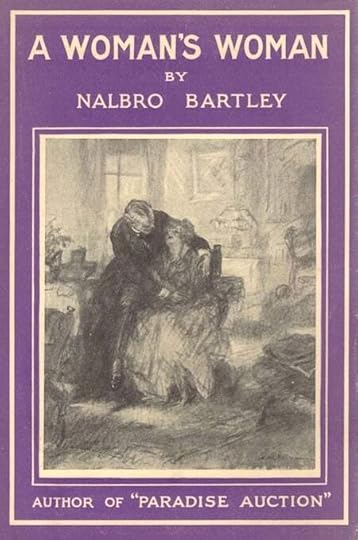
. . . . . . . . . .
Other novels by Nalbro BartleyHer previous novels included The Gorgeous Girl, 1920, “A story of contrasts — the story of one girl whose gorgeousness is all on the outside, plainly visible; and another, whose beauty and fineness are hidden within.”
Having married in her mid-twenties, Beatrice feels “the dissatisfaction not over this first year of married life but at the twenty-seven years as a Gorgeous Girl, the disappointment at not having some vital impelling thing to do.” She resolves to become another kind of woman, a very advanced woman for 1920.
She would now be an advanced woman, intellectual, daring; she would allow her stunted abilities to have definite expression. Either she would find a new circle of friends or else swerve the course of the present circle into an atmosphere of Ibsen, Pater, advanced feminine thought, and so on––with Egyptology as a special side line. She would even become an advocate of parlour socialism, perhaps. She would encourage languid poets and sarcastic sex novelists with matted hair and puff satin ties. She would seek out short-haired mannish women with theories and oodles of unpublished short stories, and feed them well, opening her house for their drawing-room talks.
The previous year Bartley had published another novel about a woman seeking her way in the modern world. A Woman’s Woman is about a woman torn between love for her wealthy businessman husband and a bohemian artist, which examines the societal pressures on the modern woman. At the age of thirty-five, with two children Sylvia rebels.
“Little by little she emerges from her home-keeping shell and joins one woman’s club after another. She is sent as [a] delegate to conventions, starts a woman’s exchange and finally becomes one of the most prominent women in the country.”
But at the end she returns to her married life; surprisingly perhaps, the reviewer in the Chicago Tribune did not approve: “the reader is expected to rejoice as the spirited heroine, for love’s sake, resumes the making of fish balls and the washing of dishes.” And in 1926 Bartley had published Her Mother’s Daughter, which contains the character Dodo Grant, more a garçonne than a flapper, more Radclyffe Hall than Zelda Fitzgerald.
Dodo Grant, her closely cut black head nodding vivaciously as she gave orders as to the seating. Dodo’s was the vitality of the Murillo type, dark, inscrutable eyes and a sallow, healthy skin. She stood out among a thousand of young things—the boyish, athletic type that could wear untrimmed hats pushed far back on her clipped head and say timely, clever things whenever conversation lagged.
It seemed natural for Dodo to smoke incessantly and wear knickers for walking. One thought of her as a sexless, delightful comrade whose main interests were golf and dogs and social settlement work. No one remarked at Dodo’s appearing at a dance in a severe white frock and upon all other occasions in mannish tailleurs and swashbuckling neckties centered by a sparkling cock made of diamonds. No one anticipated the day when Dodo Grant would marry.
Nevertheless, in the chapter “Dodo’s Secret,” we find that Dodo is secretly straight and has been infatuated with a married man, over whom she has been through a “rocky time.” “When I was nineteen his wife heard about it and made a row. She always does, they say. I was rather a wreck. No one has suspected that I was the romantic kind—I’ve never been anything but pals with the boys.”
. . . . . . . . .
Contributed by Francis Booth, the author of several books on twentieth-century culture: Amongst Those Left: The British Experimental Novel 1940-1960 (published by Dalkey Archive); Everybody I Can Think of Ever: Meetings That Made the Avant-Garde; Girls in Bloom: Coming of Age in the Mid-Twentieth Century Woman’s Novel; Text Acts: Twentieth-Century Literary Eroticism; Comrades in Art: Revolutionary Art in America 1926-1938; High Collars & Monocles: 1920s Novels by British Female Couples; and A Girl Named Vera Can Never Tell a Lie: The Fiction of Vera Caspary.
Francis has also published several novels: The Code 17 series, set in the Swinging London of the 1960s and featuring aristocratic spy Lady Laura Summers; Young adult fantasy series The Watchers; and Young Adult fantasy novel Mirror Mirror. Francis lives on the South Coast of England.
The post The Fox Woman by Nalbro Bartley (1928) appeared first on Literary Ladies Guide.
May 9, 2025
An Autumn Love Cycle by Georgia Douglas Johnson (1928; full text)
Georgia Douglas Johnson’s poetry was first published in NAACP’s The Crisis in 1916, and was subsequently included in the premier Black journals and anthologies of the 1920s. Georgia was an important figure in the Harlem Renaissance movement of the 1920s. Presented here is the full text of An Autumn Love Cycle, her third collection, published in 1928.
Though Black women’s poetry was regularly featured in the era’s periodicals, an entire collection by one writer was a rarity. Georgia published three poetry collections in the span of six years; one more was to come decades later.
Her first collection, The Heart of a Woman (1918) featured poems both specific to Georgia’s life yet universal to the female experience, speaking of love, loneliness, and women’s constrained roles. Decades later, the title of this book (and its eponymous poem) would inspire Maya Angelou’s 1981 memoir of the same name.
The poems in Bronze (1922) more directly confronted themes of race and social justice. An Autumn Love Cycle (1928) returned to more personal themes of love, motherhood, and being a woman in a male-dominated world. Arguably Georgia Douglas Johnson’s most critically praised collection, it includes “I Want to Die While You Love Me,” her most widely reprinted poem. It was recited at her funeral.
More full texts of collections by Georgia Douglas Johnson
THE HEART OF A WOMAN (1918)
BRONZE (1922)
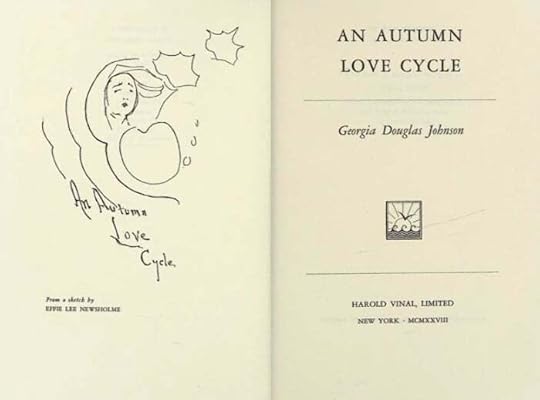
. . . . . . . . . .
An Autumn Love Cycleby Georgia Douglas Johnson (1928)
Harold Vinal, Limited, New York 1928
This book is lovingly dedicated to Zona Gale whose appreciation, encouragement,
and helpful criticism have so heartened me
Privilege to reprint certain of these poems is through the courtesy of the editors of The Crisis, The Liberator, Telling Tales, The Sphinx, Music and Poetry, Messenger, Opportunity, and The Minaret.
Foreword by Alain Locke
In the title of her first volume, The Heart of a Woman, Georgia Douglas Johnson chose with singular felicity, indeed with the felicity of instinct, her special domain in art. And as she proceeds with maturing power and courage of expression in this third volume, it becomes all the more apparent that the task which she has set herself is the documenting of the feminine heart.
Any poetic expression of life from this point of view that achieves a genuine authenticity and sincerity of emotion is as welcome as it is rare. For the emotions of woman, time-old though they be and hackneyed over as in a sense they really are, are still but half expressed. They have yet to be carried beyond the platitudes and the sentimentalizations of a man-made tradition.
Yet in the wholesome stripping off of mediaeval brocades and the laces of classic conceits, it has often occurred to us to question whether the imposition of futurist patterns and the cubist cut of the current intellectual modes has given us any more vital or adequate a revelation of the flesh and blood figure of the “eternal feminine.”
“Clothes are but clothes,” as Carlyle would say: modern feminist realism has but overlaid the vitally human with another convention, and interposed another cloak. How long shall we make a sphinx of woman, who herself now yearns to throw off along with the mystery, the psychological vestments of disguise. Our author puts it pointedly in “Paradox,”–
Alas! you love me better cold
Strange as the pyramids of old
Responselessly . . .
So, like a veil, my poor disguise
Is draped to save me from your eyes
Deep challenges.
Fain would I fling this robe aside
And from you, in your bosom hide
Eternally.
Voicing this yearning of woman for candid self-expression, Mrs. Johnson invades the province where convention has been most tyrannous and inveterate,—the experience of love. And here she succeeds where others more doctrinally feminist than she have failed; for they in over-sophistication, in terror of platitudes and the commonplace, have stressed the bizarre, the exceptional, in one way or another have over-intellectualized their message nad overleapt the common elemental experience they would nevertheless express. Mrs. Johnson, on the contrary, in a simple declarative style, engages with an ingenuous declarative style, engages with ingenuous directness the moods and emotions of her themes.
Through you I entered Heaven and Hell
Knew rapture and despair.
Here is the requisite touch, certainly for the experiences of the heart. Greater sophistication would spoil the message. Fortunately, to the gift on a lyric style, delicate in touch, rhapsodic in [t]one, authentic in timbre, there has been added a temperamental endowment of ardent sincerity of emotion, ingenuous candor of expression, and, happies of all for the particular task, a naive and unsophisticated spirit.
By way of a substantive message, Mrs. Johnson’s philosophy of life is simple, unpretentious, but wholesome and spiritually invigorating. On the one hand, she belongs with those who, under the leadership of Sara Teasdale, have been rediscovering the Sapphic cult of love as the ecstasy of life, that cult of enthusiasm which leaps over the dilemma of optimism and pessimism, and accepting the paradoxes, pulses in the immediacies of life and rejoices openly in th glory of experience.
In a deeper and somewhat more individual message, upon which she only verges, and which we believe will later be her most mature and original contribution, Mrs. Johnson probes under the experiences of love to the underlying forces of natural instinct which so fatalistically control our lives. [Especially is this evident in her suggestion of the tragic poignancy of Motherhood, where the consummation of love seems also the expiation of passion, and where, between the antagonisms of the dual role of Mother and Lover, we may suspect the real dilemma of womanhood to life.]
Whatever the philosophical yield, however, we are grateful for the prospect of such lyricism. Seeking a pure lyric gold, Mrs. Johnson has gone straight to the mine of the heart. She has dug patiently in the veins of her own subjective experience. What she has gleaned has been treasured for the joy of the search and for its own intrinsic worth, and not exploited for the values of show and applause.
Above all, her material has been expressed with a candor that shows that she brings to the poetic field what it lacks most,— the gift of the elemental touch. Few will deny that, with all its other excellences, the poetry of the generation needs just this touch to make it more vitally human and more spontaneously effective. —ALAIN LOCKE. Washington, D.C.
. . . . . . . . . . .
THE CYCLE
I Closed My Shutters Fast Last Night
I closed my shutters fast last night,
Reluctantly and slow,
So pleading was the purple sky
With all the lights hung low;
I left my lagging heart outside
Within the dark alone,
I heard it singing through the gloom
A wordless, anguished tone.
Upon my sleepless couch I lay
Until the tranquil morn
Came through the silver silences
To bring my heart forlorn,
Restoring it with calm caress
Unto its sheltered bower,
While whispering: “Await, wait
Your golden, perfect hour.”
Footsteps
Passing ever, early, late,
No fond footsteps seek my gate,
But down the winding road they wend
To some other journey’s end.
Yet,—I would not have them wait
Here within my guarded gate,
Certain footsteps I shall know,
And for them I listen low!
Oh Night of Love
Oh night of love, your rapt ecstatic hours
Were mine, the languor of their pale perfume
Pervades me, kisses in a fountain-fire,
Surround me,—fetter and consume.
Oh night of love, your groves of strange content
Project a thralldom over comind days;
Exalted, derelict, and blind I went
Unmindfully along Life’s misty ways.
Autumn
Believe me–when I say
That love like yours, at this belated hour,
Overwhelms me,—
Stills the fount of thought!
I move as one new-born–
And strange to swift transitions
As from my prison door
I gaze
Into a blinding sunlight!
Thralldom
Your voice keeps ringing down the day
In accents soft and mild,
With which you have beguiled
And wooed me as a child.
Your presence bounds my every way
And thrills me in its fold
With phantom hands that hold
Like cherished chains of gold.
Separation
Within your pulsing day
There must be little space
For visions of my face
To lure your thoughts away.
Yet, I would have it so,
To be alone the pain
That saddens love’s refrain.
Pray God you never know!
Proving
Were you a leper bathed in wounds
And by the world denied,
I’d share your fatal exile
As a privilege, with pride.
You are the very sun, the moon,
The starlight of my soul,
The sounding motif of my heart
Its impetus and goal!
Interim
The days lie dark between our jeweled meetings
Like wintry burials.
My heart bows low before the cheerless hearth
Until your voice rings through the gloom
And bids me
Wake!
And live!
Good-Bye
Let’s say ‘Good-bye’
Nor wait Love’s latest breath
Poised now so lightly on the wing of Death,
While yet within our eye one fervent gleam
Remains to hallow this, a passing dream:
Yes, yes ‘Good-bye,’
For it is best to part
While Love’s low light still burns
Within the heart!
Love’s Miracle
So like a boundless, soundless sea
The miracle of love to me
With all the world a rosy dream
Sailing upon a silver stream,
While I, a fairy in mid-air,
Am dancing, dancing everywhere.
Hark! do you hear the thunder peal?
I care not what it would reveal,
Tomorrow will be yesterday
When I am shivering and gray:
I will not heed the prompter’s ring
Let others answer, I shall sing
And dance the merrier—away!
I’ll live and live and live—today!
A Paradox
I know you love me better cold
Strange as the pyramids of old
Responselessly.
but I am frail, and spent and weak
With surging torrents that bespeak
A living fire.
So, like a veil, my poor disguise
Is draped to save me from your eyes’
Deep challenges.
Fain would I fling this robe aside
And from you, in your bosom hide
Eternally.
Alas! you love me better cold
Like frozen pyramids of old
Unyieldingly?
How My Heart Sinks
How my heart sinks when I behold the sad reflection of my face,
A wan and wistful wound, with oh, such meagre grace;
How can you hold me dear withal and conjure charms withdrawn.
Or does the Autumn twilight hold a charm unknown to dawn?
Hold! Do not speak! some day perchance, I’ll read the message dire
Within the ashes of the flame, the aftermath of fire,
Ere then perhaps I shall have found the highways of the soul
Where one may read uncrucified, the blood-words of the scroll.
Till then, uphold illusion’s veil before my gaze the while
That I may gather strength to fuse from agony, a smile!
To Time
Day by day the threads of white
Multiply, Oh! hour-glass!
How passing swift your bright sands pass,
Fain would I hold you,
Linger, bide
Until these surges shall subside,
That sweep me forward unto bliss,
Oh! charging sun, I bid you rest,
Break not your arrow in my breast!
Welt
Would I might mend the fabric of my youth
Which daily flaunts its tatters to my eyes,
Would I might compromise awhile with truth
Until love’s moon, now waxing, wanes and dies.
For I would go a further while with you
And draining this Cup of Joy so passing fair,
Which meets my parching lips like cooling dew
‘Ere time has brush cold fingers through my hair.
Review
I fear my power impotent
To hold you leal and full content,
Some hapless look or word perchance
Dispels the glamor of romance;
I tremble lest some stranger fair
Arrest you,—cause you to compare
The meagre charms which I possess
With some resplendent loveliness.
How far removed from Youth’s command
The trembling sceptre in my hand,
As miserly within the glass
I mark Love’s fleeting hours pass.
Illusion
Oh! for the veils of my far-away youth,
Shielding my heart from the blaze of the truth;
Why did I stray from their foldings and grow
Into the sadness that follows—to know.
Impotent atom with desolate gaze
Treading Life’s treacherous, intricate maze—
Oh for the veils, for the vails of my youth
Shielding my heart from the blaze of the truth!
Parody
You came,
The tapestries of love
Were shining in the sun,
My wishes settled down content
About you as you stood.
I looked into your cryptic eyes
And thought I understood;
But no,—
The splendor of your gaudy robe
Grew dimmer day by day,
I wondered,
Searched within my soul to seize the mystery.
The answer staggered me,
Aghast,
Like one at bay,
I gazed with open eyes of thought upon you,
God! ’twas true—
A mockery, a parody,
Had come to me—in you!
Delusion
You gave me your hand,
I held it to be
The last word, the dear word,
The soul’s entity;
I cherished it, treasured it,
Only to find
I held but a gauntlet—
That I had been blind!
Sunset
And now—
As one who closes up the house and goes uncaring where
He may forget the scenes of home ‘mid foreign climes and air,
I bar the chamber of my heart and seal the past within
To wander down the city’s road amid the whirr and din.
The long years seem impassable, the morning has no smile,
With naught behind these barring doors and nothing else worth while,
Like some lone pilgrim without hope, I stumble on my way,
Who lifts no futile plea for sun, but asks for clouds less grey.
Finis
I looked death calmly in the face
And placed my hand within his hand
And said:
“Come, come, let us away
For I have lost the magic key
Opening the portals of desire—
My wishes cumber in the dust,
And life is stagnant
in
my
heart!
. . . . . . . . . . . .
CONTEMPLATION
Ivy
I am a woman
Which means
I am insufficient
I need—
something to hold me
Or perhaps uphold.
I am a woman.
Joy
There’s nothing certain, nothing sure
Save sorrow. Fragile happiness
Was never fashioned to endure;
For joy repels the perfect claim
And answers to no certain name;
How furtively we scan the mist
Perchance amid the gloom to find
Some moments rare and rapture-kist.
One Day
God-by dear day of sunshine, rain
In flooding torrents pours
Its liquid footsteps on my roof,
Its fingers on my doors.
While I sit tranquilly within
And tell my beads of joy,
Holding a peace within my heart
Which nothing can destroy.
Attar
Fire—tears—
And the torture-chamber,
With the last maddening turn of the screw—
Only thus
Is one precious drop distilled
Of the attar of rose
Of the heart.
Youth’s Progeny
Oh the sad little dreams of the dime yesteryear
Lying cold, still and stark in the dust of their bier,
How the hear hurries back, all the long weary way,
Just to bid them good-night at the close of the day.
I Wonder
I wonder—
as I see them pass unheeded down the way,
(The women who were once beloved, imperious and gay)
Holding with frail, pale hands the cup
Of Life’s discarded wine
If memories
Are bliss enough
To make the dregs—divine!
Values
All the pretty baubles spread
Are not the answer to my need,
These tinseled trappings but beguile
This journeying, while deep within
A want unspeakable resides,
That throbs and throbs unceasingly,—
So hungering,— no banquet spread
Can tempt it, and no golden wine
Make it forget: I balance it—
The world flies upward in the scale!
Always, unsoothed, unquieted,
It aches and aches across the days
And sears the nights that sum my life.
Armageddon
In the silence and the dark
I fought with dragons;
I was battered, beaten sore
But rose again;
On my knees I fought still rising
In my pain;
In the dark I fought with dragons.
Weary tears
Cease your flowing,
Even now, the dawn appears!
Le Soir
Mute-lipped—
unquestioning grim-visaged Fate,
I cleave the shadows toward the Western Gate;
And yet—
my lagging heart still holds
Mute-arms outstretched
Unto earth’s gleaming folds.
Who knows?
perhaps Hope’s blossoms spray
In lush profusion
O’er the edge of day!
Treasure
What matters though love’s dream shall pass,
Since from the throbbing hour-glass
One golden-throated moment pres’t
Its attared incense to my breast.
Since I have known the purple gleam
That lifts above me—can I deem
The way unlighted—when I go
Encircled by love’s afterglow?
Retrospection
After all—
mine is the joy
Which naught can lessen or destroy.
For love has led my flying feet
Where immortelles are springing sweet,
And everlasting skies of gold
Are memories, when earth is cold
And though our future paths should lie
Estranged, as star-ways, through the sky,
I shall not look reproof, nor find
Within this pass a charge unkind,
And lightly sorrow shall be met
For I can never know regret.
. . . . . . . . . .
INTERMEZZI
Springtime
Again it is the vibrant May,
The bursting buds, the leafing trees,
The fragrant, undulating breeze,
Call to my heart in subtlest way:
Come! come! it is a holiday.
The streamlet with unending song,
Beneath its silver veil of mist
Seems flowing, flowing, to some tryst,
While I—with inner surges strong,
Find incomplete the day, and long.
Destiny
I know my love is seeing me
As restless rivers seek the sea,
Across the night, across the days
That snare the intervening ways.
I know my love is seeking me
As Time must seek Eternity,
When nights are very still I hear
His footsteps, coming, coming near!
Envoys
Love calls me tonight
In the beat of the rain
Through the cold little drops
On my bare window-pane;
Calls and calls through the dark
Like a whispered refrain
Tapping soft on my heart
Through the bare window pane.
I Want to Die While You Love Me
I want to die while you love me,
While yet you hold me fair,
While laughter lies upon my lips
And lights are in my hair.
I want to die while you love me,
And bear to that still bed,
Your kisses turbulent, unspent
To warm me when I’m dead.
I want to die while you love me
Oh, who would care to live
Till love has nothing more to ask
And nothing more to give?
Ecstasy
Not less than this, beloved,
This beaming, highmost ray
That sweeps in royal splendor
Across our perfect day.
Not less than this,—far rather
That we should say ‘adieu,’
With every rose in Eden
Abloom for me and you.
Pledge
With kisses I’ll awake you love
So tenderly at morn,
The pledges of my fealty
Diunally reborn.
We’ll thread life’s way together love,
And when the fading light
Dips softly over western hills
I’ll kiss your eyes good-night.
Your Eyes
Your eyes—
Dark pools, so calm and deep,
A thousand ages in them sleep,
A dreaming world within them lies,
And all my hopes
Of paradise!
Amour
Kiss me!
And let the hours bloom triumphantly
Before life’s little sun has set
And I am old.
Love me!
The day is fleet
And I . . . .
Am far too passionate
To die!
Finality
When love’s triumphant day is done,
Go forward! leave me to the night
Beneath the coldly staring stars,
The waiting winter and its blight.
For I would never hold the heart
That mutely quivers to be free,
Unfurl your restless wings—away!
And leave the emptiness to me.
In Love
I lived in Hell the other day
Its fires wrapt me angrily,
But now their horrors fall and fade
Like ghosts that memory has made.
I lived in Hell even today,
How sift the fierce flames die away—
Submerged with kisses, I forget,
With tears upon my pillows yet.
Fiction
Ah! love!
I shall not seek to penetrate
Your webbed gauze
Nor tease my heart
By queries deep,
But hold you tenderly;
The day is evening,
And I must cull my flowers
‘Ere dark.
Dead Days
Dead days of rapture and espair
I would your hours exhume,
Renew their wildness once again
Their rigors and perfume.
. . . . . . . . . . .
PENSEROSO
Break, Break My Heart
Break, break my heart
For love is done,
The pale light trails the dying sun—
And night awaits—no hope—no stars
Darkness
Hide my scars!
Little King
From worshipping I now arise
Stunned and aghast, with opoen eyes
I see the real, the little you
I thought so gallant, brave and true.
A pity yet is mine, I fear,
Since wherefore comes this falling tear,
For none among your fawning throng
Will love you well, nor love you long.
Romance
When I was young
I used to say:
romance will come risding by
And I shall surely smile
And play with him awhile.
When I grew older
then I said:
romance may come riding by
I wonder shall I smile
And play with him awhile?
But now—
Alas! I only say:
Romance never will come by
And I shall never smile
He has been dead the while!
Falling Gods
Confusion, desuetude and gloom,
The travailing of sound,
Fell desolation in my soul,
And agony profound;
The gods are falling heavily
And for all time to be,
And never more my heart shall know
A shrine to Deity!
Armour
You cannot hurt me any more
For I am armored now
And I can look into your face
With cool, unfevered brow.
The tranquil river meets the sea,
My life flows on at rest,
Unurged, untorn, but oh, my God!
I love the old way best!
Divide
Your light’s breath may fan my cheek
Your whisper stir me when you speak,
And yet—
The teeming planets play
Between your heart—and mine
Today.
Return
Now,
Like the pines intoning
Though some solitary gloom
My errant thoughts go pattering
About love’s ancient tomb,
And though no breath of incense rare
Lies round the shattered cup,
A banquet weird, the fragments
Where the ghost of love
May sup.
Song of the Sinner
Just a bit of ashes
Grey, grey ashes—spent—
God! how fierce the fires burned
Down to this continent.
Just a bit of ashes,
Not a single spark
Lives in this residuum
Crumbling cold and dark.
Just a bit of ashes—
To the judgment day,
I go with my memories—
Pray, sweet virgin, pray!
Celibacy
Where is the love that might have been
flung to the far ends of Earth?
In my body stamping around,
In my body like a hound
Leashed and restless—
Biding time!
. . . . . . . . . . .
CADENCE
Offering
I seek no tokens of you dear
I only ask to give
The purple flower of my heart
And you will let it live.
I ask no fealty or plight,
I only pray that you
May find earth’s barren places bright
Perhaps, because it grew.
And when for you the final sun
Moves toward the darkening West,
I shall be lingering to place
Love’s flower on your breast.
Estrangement
Some day I shall be dead, and pride
Which kept me from your feet,
Shall be the burden of the song
My cold lips shall repeat.
And some day when you too shall find
A pillow in the sod,
Would you then spurn an hour with me
Above—where daisies nod?
Recessional
Consider me a memory—a dream
That passed away,
Or yet, a flower that has blown and shattered—
In a day;
For passion sleeps, alas, and keeps no vigil
With the years,
And wakens to no conjuring
Of orison or tears.
Consider me a melody
That served its simple turn,
Or but the residue of fire
That settles in the urn,
For love defies puring reasoning
And undeterred flows
Within—without
The vassal heart!
Its reasoning—
Who knows?
Sepulchre
I have mounded the corpse of my sorrow
And wreathed it with roses fair
That none who may pass on the morrow
May know what lies buried there.
Curtain
When one has lived
‘Tis not so hard
To fold the hands,
To say, “Good-night,”
and creep away
Behind the dark:
But ’tis not strange
The heart rebels
When sounds of night
Ring down the day
That was a weary, joyless way
From early dawn
To setting sun:
How eagerly we trail the light
For crumbs of happiness we fend,
And struggle, struggle—to the end!
Afterglow
Through you I entered heaven and hell,
Knew rapture and despair,
I flitted o’er the plains of earth
And scaled each shining stair:
Drank deep the waters of content,
And drained the cup of gall,
Was regal and was impotent,
Was suzerain and thrall.
Now, by Reflection’s placid pool
On evening’s mellowed brow,
I smile across the backward way
And pledge anew my vow;
For every glancing, golden gleam,
I offer gladly—pain!
And I would give a thousand world
To live it all again!
FINIS
The post An Autumn Love Cycle by Georgia Douglas Johnson (1928; full text) appeared first on Literary Ladies Guide.
May 8, 2025
Fascinating Biofiction: Novels About Real-Life Women
If you love learning about fascinating women of the past, but aren’t inclined to read full-scale biographies that take you from the second they were born (or earlier) to the minute they died, another fantastic route into their lives is via novelizations, also known as biofiction.
This type of novel usually focuses on a particularly interesting portion of a fascinating real-life person’s journey. This seems to be a growing genre, and when done well, as in the small sampling following, is entertaining as well as illuminating.
To create these novelizations successfully requires a delicate balance involving deep research and creative license. Here’s a small sampling.
. . . . . . . . . .
Saving Vincent:A Novel of Jo van Gogh Bonger
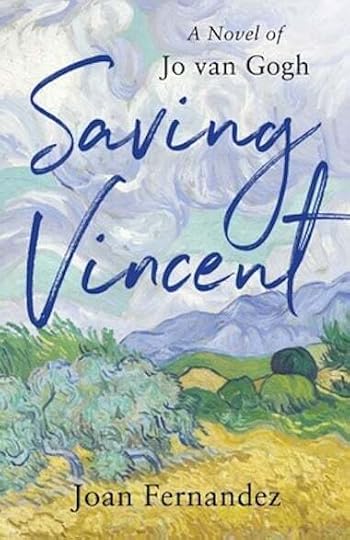
Last year, my book group read The Secret of Sunflowers, which, like Saving Vincent, fictionalizes the story of Jo van Gogh Bonger. Sunflowers alternates chapters about Jo with those about a fictional modern-day woman who is pretty forgettable. I found the contemporary story distracting and after finishing the book, I wished that someone would write a novel focusing only on Jo.
I got my wish with Saving Vincent: A Novel of Jo van Gogh (2025) by Joan Fernandez. It’s based on the true story of the widow of Theo van Gogh, Vincent’s devoted brother. She singlehandedly rescued Vincent van Gogh’s artistic legacy — without her, he would have been lost to history. Here, Joan introduces her novel:
“In 1891, timid Jo van Gogh-Bonger lived safely in the background of her art dealer husband Theo’s passionate for selling work by unknown artists, especially his ill-fated, deceased brother Vincent.
When Theo van Gogh died unexpectedly, Jo’s brief happiness was shattered. Her inheritance—hundreds of unsold paintings by Vincent—was worthless. Pressured to move back to her parents’ home, Jo defied tradition, opened a boarding house to raise her infant son alone, and chose to promote Vincent’s art herself.
Her ingenuity and persistence drew the powerful opposition of a Parisian art dealer who vowed to stop her and sink Vincent into obscurity. It would take Jo fifteen years for the world to finally take note of Vincent van Gogh.”
Can you imagine a world without the art of Vincent van Gogh? Jo made the world a richer place with her passionate belief in her brother-in-law’s brilliant work. Read more about Saving Vincent.
. . . . . . . . . .
Solitary Walker:A Novel of Mary Wollstonecraft
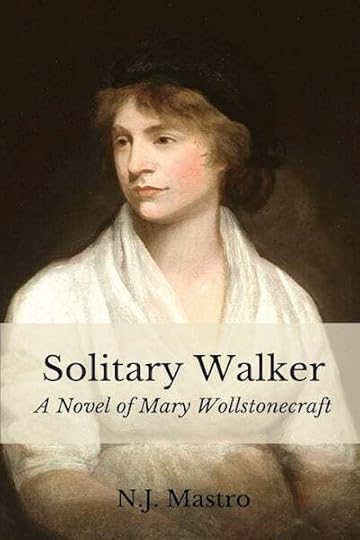
I’m a bit obsessed with Mary Wollstonecraft and her daughter, Mary Shelley. The elder Mary was an early women’s rights advocate, best known for A Vindication of the Rights of Woman, and the younger Mary for producing the first work of science fiction, none other than Frankenstein (1818), written while still in her teens. Mary died nine days after giving birth to her namesake daughter.
N.J. Mastro’s novel, Solitary Walker, skillfully imagines the most formative and fascinating episodes of Mary Wollstonecraft’s brief life. From the publisher’s description:
“England, 1787. Mary Wollstonecraft is an avowed spinster. At 28, she moves to London to live independently as a writer. With her publication of A Vindication for the Rights of Woman a few short years later, she emerges as a leading figure for women’s equality. But when a humiliating faux pas threatens her reputation, Mary travels to Paris to write about the French Revolution, where she unexpectedly falls in love with American adventurer Gilbert Imlay.
Her ill-timed affair occurs just as the Reign of Terror begins, forcing Mary to decide whether to leave Paris—and Imlay. Her writing has branded her a revolutionary. If she stays, she is sure to face a trip to the guillotine. The choice Mary makes alters her life forever.
Readers of biographical fiction will embrace this carefully researched novel about the woman historians widely consider the world’s first feminist. Told against the backdrop of Wollstonecraft’s incredible rise as a writer, the French Revolution, and a solo journey along the remote shores of Scandinavia, Solitary Walker is the timeless story of women forging their own path.”
My favorite parts of the novel were those that involved Mary’s relationship with Gilbert Imlay, because let’s face it, complicated relationships are so compelling. This novel of the complicated and compelling Mary is an engrossing read, illuminating the a brief and blazing life.
. . . . . . . . . .
The Personal Librarian(a novel of Belle da Costa Green)
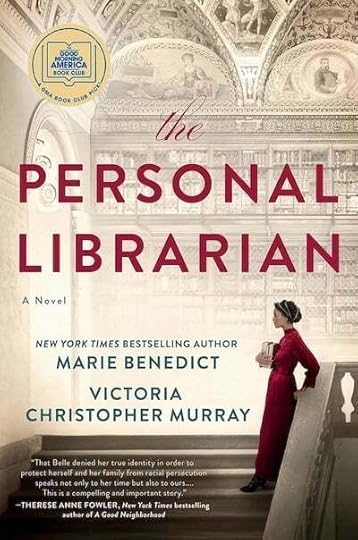
The aforementioned N.J. Mastro, author of Solitary Walker (just above), contributed this article about Belle da Costa Green, the real-life figure behind The Personal Librarian. Within it, Mastro includes a review of the novel:
“The Personal Librarian is poignant, engaging, and instructive. Readers discover Belle da Costa Greene while the authors also bring to life two unique worlds, that of rare books and fine art.
Upon the recommendation of his nephew Junius Morgan, J.P. hires Belle da Costa Greene to purchase and curate his growing collection of rare books, manuscripts, book-related artifacts, and artwork. At the time, Belle was working as a librarian at Princeton, a white male-only university. Junius discovered Belle’s talent during his frequent visits to Princeton’s rare book collection. Her exceptional knowledge impressed him, as did her witty, animated personality.
Belle dazzles her new employer from the start. Because a great deal of business occurs in social settings as much as at auctions and by private arrangement, J.P. introduces her to New York society, where she makes an indelible impression. Soon she is traveling the world searching for the rarest of books, the most exquisite artwork money can buy, and antiquities few people have ever seen.
Throughout what appeared a charming, glamorous existence, Belle is forced to carry the secret of her true identity. If discovered, she would be fired. Not only would this destroy her career as a librarian, it would also take away her livelihood. Besides supporting herself, she was the breadwinner for her mother and siblings, to whom she provided food, clothing, shelter, and education.”
. . . . . . . . . .
Harlem Rhapsody(a novel of Jessie Redmon Fauset)
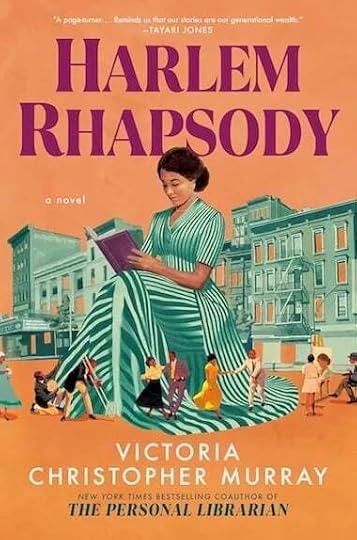
I hope to get to the The Personal Librarian (above) soon; but I jumped ahead and listened to the new book by Victoria Christopher Murray (co-author of The Personal Librarian) — Harlem Rhapsody, a novel of Jessie Redmon Fauset.
I so enjoyed this book, as I am completely enamored of the Harlem Renaissance era and its writers. It’s wonderful that Jessie Fauset, who was not long ago in danger of being completely forgotten, is being honored in this way. She was a talented novelist, essayist, and poet in her own right; and in her capacity as literary editor of NAACP’s iconic journal The Crisis, she discovered and nurtured many of the legendary writers of that era (not the least of which was Langston Hughes).
The novel draws upon newly discovered evidence of the love affair between Jessie and the eminent W.E.B. Du Bois. It touches on the racial bias that Jessie, an intellectually gifted and highly educated woman had to continually endure in her quest for professional advancement. Sometimes the prose is a bit workmanlike, and occasionally the research jumped out, but I loved every second of the listening experience (narrated by Robin Miles).
. . . . . . . . . .
The Bohemians by Jasmin Darznik(a novel of Dorothea Lange)
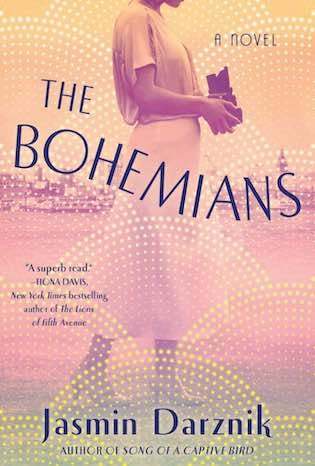
This is a wonderful novelization of the early career of Dorothea Lange, the esteemed photojournalist. Her photographs captured many major historical events of the twentieth century, including the Dust Bowl and the Japanese-American internment camps. She’s best known for the instantly recognizable portrait “Migrant Mother.”
Jasmin contributed 10 Fascinating Facts About Dorothea Lange, which makes an excellent introduction to this trailblazer. About the novel, from the publisher:
“In 1918, a young and bright-eyed Dorothea Lange steps off the train in San Francisco, where a disaster kick-starts a new life. Her friendship with Caroline Lee, a vivacious, straight-talking Chinese American with a complicated past, gives Dorothea entrée into Monkey Block, an artists’ colony and the bohemian heart of the city.
Dazzled by Caroline and her friends, Dorothea is catapulted into a heady new world of freedom, art, and politics. She also finds herself unexpectedly falling in love with the brilliant but troubled painter Maynard Dixon.
Dorothea and Caroline eventually create a flourishing portrait studio, but a devastating betrayal pushes their friendship to the breaking point and alters the course of their lives. The Bohemians captures a glittering and gritty 1920s San Francisco, with a cast of unforgettable characters, including Frida Kahlo, Ansel Adams, and D. H. Lawrence.
A vivid and absorbing portrait of the past, it is also eerily resonant with contemporary themes, as anti-immigration sentiment, corrupt politicians, and a devastating pandemic bring tumult to the city—and the gift of friendship and the possibility of self-invention persist against the ferocious pull of history.”
I found this novel incredibly satisfying, as I had watched a documentary about Dorothea Lange just before listening to it. I loved its focus on her early career and San Francisco years, highlighting the challenges a woman with her talent and ambition faced some one hundred years ago. Some things have changed, others haven’t …
. . . . . . . . . .
The Other Alcott (a novel of May Alcott)
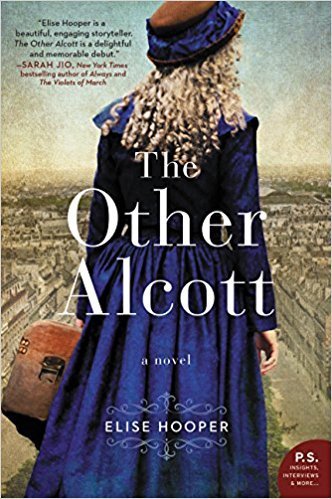
The Other Alcott (2017) by Elise Hooper is an imagining of the life of May Alcott. The youngest of the Alcott sisters, she inspired the character of Amy March in Louisa May Alcott’s Little Women. May (after marriage known as May Alcott Nieriker) was a talented visual artist. In this work of historical fiction, Elise Hooper gives readers a glimpse into the youngest Alcott’s artistic pursuits and her side of the sibling rivalry. From the publisher:
“Many of us grew up knowing the story of the March sisters, heroines of Little Women by Louisa May Alcott. But while most fans cheer on Jo March, based on Louisa herself, Amy March is often the least favorite sister. Now, it’s time to learn the truth about the real Amy — Louisa’s sister, May. This lesser-known sister, the free spirit, the girl who decorated her walls—was she really the brat she was portrayed to be in her sister’s novel?
May begins to question her relationship with her sister as well as her dream to be an artist when her illustrations for Little Women are received poorly by reviewers. This inspires May to embark on a quest to discover her own true identity as an artist and a woman. Starting with art lessons in Boston and moving on to Rome, London, and Paris, this talented, and determined woman forges a life on her own terms, making her so much more than merely ‘The Other Alcott.’”
In a conversation reprinted on Literary Ladies’ Guide, Elise Hooper sums up why she chose May as the subject for this novel:
“She was such an optimistic figure, despite the many challenges that faced her, and she’s always been overshadowed by her infinitely more famous older sister, making me feel that her story needed to be told. Furthermore, I thought many modern readers would relate to May’s struggle to balance her desire for a career with her search to find love.”
Interestingly, Elise Hooper also came out with a novel of Dorothea Lange’s life titled Learning to See. Though I haven’t read it, it sounds like it would be a good companion to Jazmin Darznik’s novel, above, as Learning to See centers around Dorothea’s documentation of the Japanese American internment camps of the WWII era.
. . . . . . . . . .
Charlotte & Arthur(a novel of Charlotte Brontë)
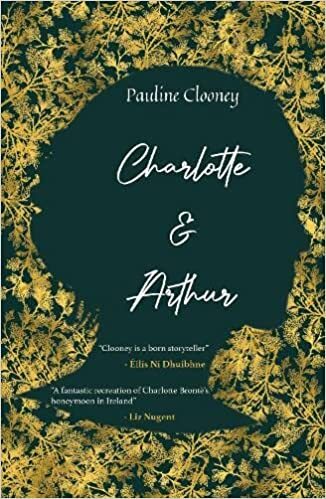
Charlotte & Arthur by Pauline Clooney (2021) is a richly imagined novel about the wedding and subsequent Irish honeymoon of Charlotte Brontë and Arthur Bell Nichols, the curate who worked with her father at Haworth parsonage. This novel is based on meticulous research by Ms. Clooney, an award-winning short story writer and the founding director of Kildare Writing Centre in Ireland.
The narrative focuses on a little-known time in Charlotte’s life. Though she’s a celebrated author at home and abroad, the siblings she grew up with (Emily, Anne, and Branwell Brontë) have all died, leaving only Charlotte and her father, the Reverend Patrick Brontë, from a family that once numbered eight members.
Charlotte is bereft and lonely, but the Rev. Brontë isn’t enthusiastic about her marriage to his curate. She herself took many years to warm up to Arthur. But finally, he won her heart, and this is where we pick up the story.
I had the pleasure of interviewing Pauline Clooney, and asked why she chose the novel form to tell the story of this part of Charlotte’s life. She responded:
“I think the story of her marriage to Arthur is as romantic, and alas, because of the brevity of their time together, as tragic, as the Brontë’s lives and works, and I felt the novel form might do more justice to that mix of romance and tragedy, than the hard facts of non-fiction.” Read the entire interview here.
The post Fascinating Biofiction: Novels About Real-Life Women appeared first on Literary Ladies Guide.
May 7, 2025
The Technique of the Love Affair, by A Gentlewoman (1928)
The Technique of the Love Affair (1928) sums up the new attitude to men, sex and relationships of the modern woman of the late 1920s perfectly, not to say outrageously and shockingly.
It gives cynical and completely amoral guidance to young women on how to master and dominate men without ever falling under their spell; the woman who follows its advice will always be in control, never be in love and never be subservient to a man, says the author.
Although the book always has its tongue firmly in its cheek, and although it is no doubt intended as comic relief, it still probably presents and represents the thinking of the dedicated 1920s flapper better than any other book of the period, fictional or otherwise.
“The Technique of the Love Affair makes, I am bitterly afraid, considerable sense. If only it had been written and placed in my hands years ago, maybe I could have been successful, instead of just successive.” (— Dorothy Parker)
. . . . . . . . . . . .
“Your love affair should be hedged about with flirtations, and your lover should believe – preferably with accuracy – that several others would clamour for his place of favour and intimacy if he relaxed his hold upon you. But, though you should find means to display your admirer to your lover, you must not flaunt your lover before your admirers. (Interpret ‘lover’ in anywhere you choose, so long as it implies the most favoured of those who surround you.)”
. . . . . . . . . . . .
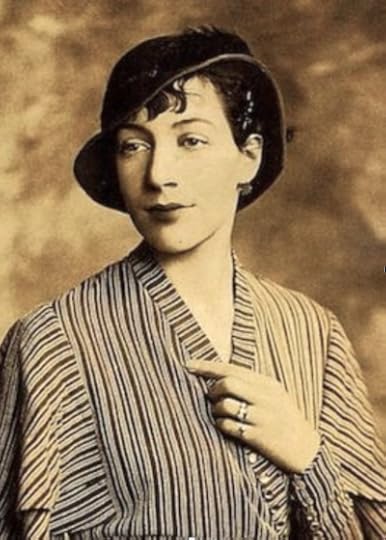
Doris Langley Moore
. . . . . . . . . . . .
The Technique of the Love Affair was originally published pseudonymously as by “A Gentlewoman,” though it was actually written by a young Doris Langley Moore (1902-1989), the distinguished British fashion writer, fashion historian – she founded the Museum of Costume in Bath – and Hollywood costume designer – responsible for, among others, Katherine Hepburn’s outfits in The African Queen.
In a long career, lasting from the 1920s to the 1970s, Moore wrote many other books, including several on fashion and social life, including Pandora’s Letter Box; being a Discourse on Fashionable Life as well as light, enjoyable novels such as Not at Home and All Done by Kindness and biographies of notable women, in particular E. Nesbit, author of The Treasure Seekers, The Phoenix and the Carpet and The Railway Children.
She also wrote about Ada Lovelace, Lord Byron’s daughter, as well as four books on the “mad, bad and dangerous to know” Byron himself. She was awarded an OBE in 1971.
Moore was born in 1902, so she was a young woman herself when she wrote The Technique of the Love Affair and not the hard-bitten, older cynic whose voice the book purports to convey. But the book was nevertheless admired by that epitome of the hard-bitten, older cynic herself: Dorothy Parker, she of Vicious Circle and Algonquin Round Table fame.
Parker herself was only thirty-five in 1928 but she had already been writing acerbic theatre criticism, initially for Vanity Fair, for ten years. A woman not easily humbled, Parker read the book at the time and wrote about it in awestruck, almost reverential terms in the New Yorker for November 17, 1928.
“Well, to get back to me as quickly as possible—when Our Heroine found that she was the bust of the season as a wit and an elocutionist, she decided to turn to that good old stand-by, sex. ‘Let others raconteur if they will,’ I said, ‘but gangway while I go Garbo!’
To that end, I acquired a book called The Technique of the Love Affair, by one who signs herself “A Gentlewoman,” and set out to learn how to loop the Usual Dancing Men.
I have thought, in times past, that I had been depressed. I have regarded myself as one who had walked hand-in-hand with sadness. But until I read that book, depression, as I knew it, was still in its infancy. I have found out, from its pages, that never once have I been right. Never once. Not even one little time.
You know how you ought to be with men? You should always be aloof, you should never let them know you like them, you must on no account let them feel that they are of any importance to you, you must be wrapped up m your own concerns, you may never let them lose sight of the fact that you are superior, you must be, in short, a regular stuffed chemise And if you could see what I’ve been doing!
Despite its abominable style and frequent sandy stretches, The Technique of the Love Affair makes, I am bitterly afraid, considerable sense. If only it had been written and placed in my hands years ago, maybe I could have been successful, instead of just successive.”
. . . . . . . . . . . .
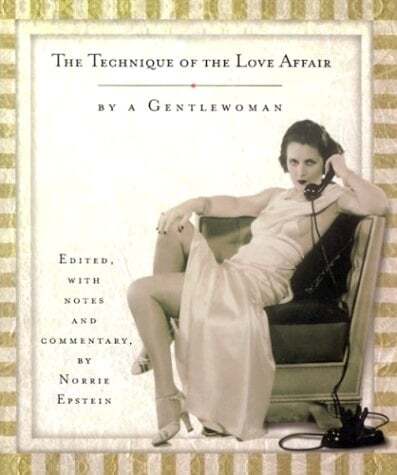
. . . . . . . . . . . .
A spoof Socratic dialogueThe Technique of the Love Affair is a spoof of a Socratic dialogue, with the older woman Cypria (named after Venus’ birthplace) educating her naïve young friend Saccharissa in the ways of the world. Cypria points out that, since the First World War, there has been a marked lack of eligible men. Women have to fight for them on as near-equal terms as they can; they must “resort to artifice in order to obtain him.” And this artifice must be learned and practiced.
“In the love affair, as in sculpture, poetry, and every other fine art, no lasting success can be achieved without skill.” But, Cypria caveats, she is by no means advocating promiscuity – like a true artist, the woman must be selective in her pursuits; “An artist, whichever Muse he follow, must be exquisitely selective.”
One of Cypria’s first lessons is about chastity, or rather the need for a lack of it in the modern woman. In Victorian times, she says, women were “too delicate and romantically honourable for words . . . physical purity and innocence were then highly fashionable.” But in the modern, post-war world, these virtues have necessarily been greatly diminished.
Cypria: Money, birth, rank, respectability – they are all worth less than they were. It was not man, but woman herself, who relegated chastity to a more reasonable position among the virtues. Far be it from me to insinuate that she has discarded it, but she no longer vaunts it as her proudest boast. It is no longer her main-stay, her protection, her chief allurement.
Cypria also warns her young friend of the dangers of falling in love and thus losing control. For the woman of 1928, “the one thing essential is self-confidence.” If a young woman like Saccharissa is afraid of losing a man, he will soon gain “an importance in your thoughts quite disproportionate to his merits.”
Cypria tells her, “if you are unwaveringly sure of yourself, and are free from all the alarms of a woman troubled with a sense of inferiority, your judgement will be cool and clear, and, in short, you cannot become infatuated.” Also, says Cypria, the young woman must make sure not to give up her friends and interests in favor of a potential love interest:
Never will they be more useful to you than now, when you will need all the diversions at your command to prevent your mind from fixing to firmly on one object. Remember also that as often as your lover, or prospective lover, sees you engrossed with people and things to the apparent exclusion of himself, he will be stimulated to a fresh effort to win you. And should the affair eventually fall through, how much lighter will be your pangs if it is only one attachment severed among many that remain.
Another of Cypria’s lessons is in the use of flirtation to attract a man, this being another of the arts that a woman needs to master in the modern world of 1928; she needs to know exactly to what degree she can respond to the man’s advances. Saccharissa asks how much of a response she should give. Cypria implies that it is permissible to go the whole way, though only in very limited circumstances.
Cypria: As long as you do not respond as much as he would like – as long as you almost seem to be doing so under protest (not the protest of disinclination, mark you, but of modesty, or conventionality, or any other obstacle you may have chosen), you might make a little show of surrender.
Saccharissa: And that is called coquetry, I suppose. How long must I go on with that kind of thing?
Cypria: Almost for ever, I am afraid. You dare not cease to give a little less of yourself than is wanted, a little less than satisfies, save on the rarest occasions, and those should decidedly be foreign to the period of approach.
Cypria devotes considerable time to schooling Saccharissa in the art of capturing a man and making him want to marry her. But, even after marriage, she insists that a woman has to stay attentive, attractive and alluring. Cypria maintains that a married woman is perfectly entitled to flirt with other men, even if they themselves are married.
The word adultery is not used, but Cypria’s Machiavellian amorality comfortably encompasses it. She even advocates that for a married woman, as for an unmarried one, encouraging multiple suitors to compete with each other and even to compete with her husband, is a positive thing.
Cypria: Do you know, I’m beginning to believe that a wife ought to gather together a little circle of admirers in order to ensure the happiness of her home. It’s positively altruistic!
Saccharissa: You are joking now.
Cypria: Well, perhaps I am, but there’s a grain of truth in the jest.
Saccharissa: I suppose you would never pause to consider the men whose feelings are to be played upon for the diversion of the married woman?
Cypria: My dearest Saccharissa, after all the trouble I have taken with you, how can you be so naïve? I will not even ask you why such an unfortunate, handicapped creature as a woman should be expected to consider the feelings of the sex which has her at a disadvantage: I will merely put it to you that the men who take part in the flirtations we are discussing may derive easily as much pleasure and benefit from them as the woman.
Although Cypria’s views are obviously exaggerated for comic effect and to cause deliberate outrage, even offense, they probably do represent very closely the views of the twenty-six-year-old, independent-minded fashionable flapper that her author was and beautifully, hilariously capture the feelings of many characters in the 1928 novel.
. . . . . . . . .
Contributed by Francis Booth, the author of several books on twentieth-century culture: Amongst Those Left: The British Experimental Novel 1940-1960 (published by Dalkey Archive); Everybody I Can Think of Ever: Meetings That Made the Avant-Garde; Girls in Bloom: Coming of Age in the Mid-Twentieth Century Woman’s Novel; Text Acts: Twentieth-Century Literary Eroticism; Comrades in Art: Revolutionary Art in America 1926-1938; High Collars & Monocles: 1920s Novels by British Female Couples; and A Girl Named Vera Can Never Tell a Lie: The Fiction of Vera Caspary.
Francis has also published several novels: The Code 17 series, set in the Swinging London of the 1960s and featuring aristocratic spy Lady Laura Summers; Young adult fantasy series The Watchers; and Young Adult fantasy novel Mirror Mirror. Francis lives on the South Coast of England.
The post The Technique of the Love Affair, by A Gentlewoman (1928) appeared first on Literary Ladies Guide.
May 4, 2025
Literary Gift Box Ideas Inspired by Iconic Women Writers
Literary gift boxes are a fun and thoughtful way to celebrate great books and authors. These boxes are perfect for book lovers who enjoy reading and want something special. These are great for birthdays, holidays, or book clubs.
You can fill these boxes with items inspired by famous women writers. With the right packaging, items, and design, you can create a gift box that reflects the writer’s theme.
Let’s explore some unique ideas to create a gift box that every book lover will appreciate and cherish.
What is a Literary Gift Box?
A literary gift box is a special box made for people who love books. It includes items that match a book, an author, or a reading theme. These boxes often come with a book, a bookmark, snacks, candles, and other small gifts.
Everything inside the box is picked to make the reading experience more fun and personal. Literary gift boxes are perfect for birthdays, holidays, book lovers, and fans of classic stories. They turn reading into a full experience and make every gift feel thoughtful and unique.
Creative Packaging for Literary Gift Boxes
The packaging is just as important as what’s inside. Stylish packaging makes the gift feel extra special. You can use custom book rigid boxes with book quotes, tie them with twine or velvet ribbon, or seal them with wax for a vintage look. Wrapping items in old book pages adds a unique touch.
You can also include a name tag or sticker that matches the theme. Choose colors that reflect the book or author, like soft colors for Jane Austen, or darker tones for Mary Shelley.
Themed Literary Gift Box Ideas
A theme makes the box more fun. You can choose a specific author, book, or even a time.
Some fun ideas include a Victorian Style Box for Jane Austen fans or a Gothic Mystery Box inspired by Mary Shelley. You can also make a Nature and Poetry Box based on Emily Dickinson or a Modern Classics Box for Virginia Woolf lovers.
Pick a theme your reader will enjoy. It makes the gift more personal and exciting.
Personalization Ideas
Personal touches show you care. You can fill the box with items that reflect the author’s writing style. You can include a copy of a classic book, a customized bookmark, or a notebook or journal. A candle or tea blend adds a personal touch.
Don’t forget a quote card or poem from the author. Furthermore, small gifts like pens oe art prints can enhance the experience for the gift recipient. It makes the unboxing experience unforgettable.
. . . . . . . . .

Sample mailer box by Elite Mailer Boxes
. . . . . . . . .
Today, many people prefer packaging that is eco-friendly and stylish. Use recyclable kraft boxes (see above) and reusable fabric wraps or cloth bags instead of plastic. For stuffing, choose biodegradable shredded paper.
If you want to print anything, try using soy-based inks. For tags and cards, recycled paper is a great choice. This shows you care about the environment. Here are some sample gift box ideas based on iconic women writers:
. . . . . . . . . .
Jane Austen-Inspired Gift Box
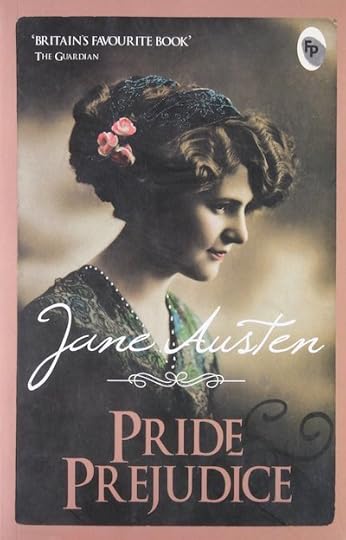
. . . . . . . . . .
Virginia Woolf-Inspired Gift Box
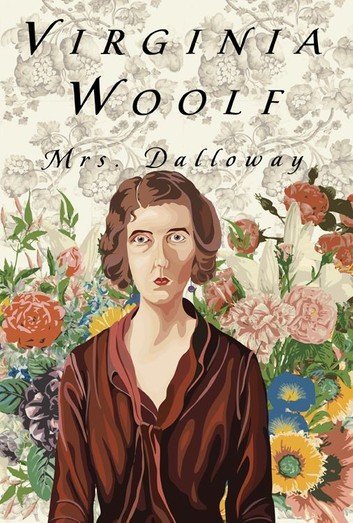
. . . . . . . . . .
Emily Dickinson-Inspired Gift Box
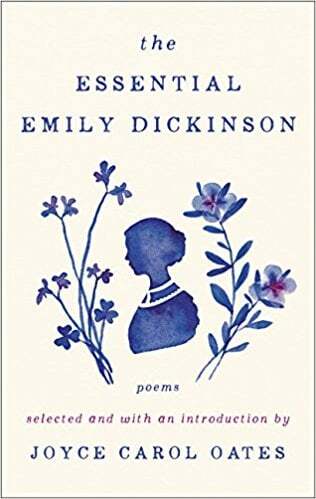
. . . . . . . . . .
Mary Shelley-Inspired Gift Box
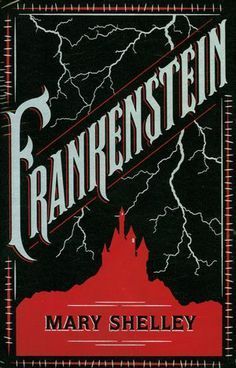
Who Would Love These Literary Gift Boxes?
These literary gift boxes are perfect for book lovers of all kinds. They make great gifts for:
Literature studentsTeachers and librariansWriters and poetsFeminist readersBook club friendsThese boxes are great for special days like birthdays, graduation, or holidays. They are perfect for readers who love classic stories and admire strong women in literature.
Literary gift boxes inspired by iconic women writers are more than just gifts. With the right mix of books, thoughtful items, creative packaging, and a personal touch, you can make every box feel magical.
Whether you go bold with Toni Morrison or sweet with Louisa May Alcott, there’s a style for every reader. If you want to give a gift that feels thoughtful and full of meaning, start with a literary gift box.
The post Literary Gift Box Ideas Inspired by Iconic Women Writers appeared first on Literary Ladies Guide.
April 29, 2025
Literary Centenaries: Classic Fiction by Women Writers from 1925
There’s a lot of hoopla around 2025 being the centenary of The Great Gatsby by F. Scott Fitzgerald, published in 1925. It’s the quintessential novel of what’s come to be known as the Jazz Age.
But it’s not the only centenary worth celebrating in 2025. There was some great 1925 fiction that came from the pens (and typewriters of women writers, including Virginia Woolf, Zora Neale Hurston, Willa Cather, Anita Loos, Anzia Yezierska, and more.
Poor Scott Fitzgerald didn’t live long enough to see the lasting legacy of his work (he was gone by 1940, at the age of 44). There’s a LOT (this is the listing on Google News alone) of news and editorializing about Gatsby. It’s kind of cool that a book is getting so much attention in the midst of all the horrors we’re living through — kind of a testament to the power of literature.
So this got me to wondering … what were the literary ladies up to in 1925? What centenaries are being swept aside or not discussed enough? Let’s give them some centenary love as well. Here are just a few …
. . . . . . . . . .
Mrs. Dalloway by Virginia Woolf
Mrs. Dalloway, arguably one of Virginia Woolf‘s most accessible novels, describes a day in the life of Clarissa Dalloway, an upper-class woman preparing to host a party that evening. The unique aspect of the novel is that it focuses on her inner world, and that of the peripheral characters, taking the reader as she travels back in time.
Unusual for its time in using stream of consciousness as literary structure, the novel was met with positive response, and often appears on lists of best novels of the twentieth century.
As Clarissa goes around London, buying flowers and doing other preparations for the evening, she reflects on her youth and her choice of husband. She ruminates on a former suitor, the enigmatic Peter Walsh, and her youthful flirtation with Sally Seton. The novel covers many themes including time, mental and physical illness, the role of women in society, regret, sexuality, and more.
“He thought her beautiful, believed her impeccably wise; dreamed of her, wrote poems to her, which, ignoring the subject, she corrected in red ink.”
Read more lovely quotes from Mrs. Dalloway here.
Mrs. Dalloway’s centenary is coming right up on May 14. but Google News UK doesn’t list a fraction of the kind of press being bestowed upon Gatsby on this side of the Atlantic, but hopefully it will get its due on its actual birthdate.
. . . . . . . . . .
“Spunk” — the short story thathelped launch Zora Neale Hurston’s career
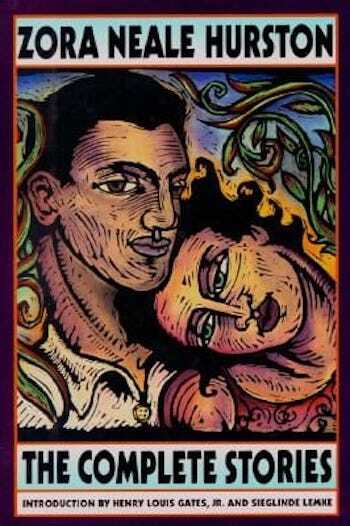
Zora Neale Hurston’s short story, “Spunk” (1925), helped launch her career as a fiction writer. She had already established herself as an ethnographer and folklorist, having been the first Black student to study anthropology at Columbia University in New York City.
“Spunk” was originally published in the prestigious Opportunity, A Journal of Negro Life, and got Zora’s literary career off to a running start. The story won second place in the journal’s fiction writing contest. At the awards dinner on May 1, 1925, Zora also won second place in the drama category for her play, Color Struck, plus two honorable mentions. These early successes helped assure Zora’s place as a writer in the creative world of the Harlem Renaissance of the 1920s.
Here, you can read the full text of “Spunk,” which in recent times has been adapted for the stage.
. . . . . . . . . .
The Professor’s House by Willa Cather
The Professor’s House by Willa Cather, published in 1925, is one of this American master’s mid-career novels. The story of Professor Godfrey St. Peter tells of a midlife crisis — before the term was coined.
When the professor and his wife move into a new house, he begins questioning the path that his life has taken. His daughters have grown up, and he loses much of his will to live, not finding anything to look forward to. Though it hasn’t achieved the enduring stature of some of Cather’s better-known works, in her skilled hands, The Professor’s House becomes a touching story of personal and spiritual self-reflection.
“The man he was now, the personality his friends knew, had begun to grow strong during adolescence, during the years when he was always consciously or unconsciously conjugating the verb ‘to love’ — in society and solitude, with people, with books, with the sky and open country, in the lonesomeness of crowded city streets.”
IMHO, Willa Cather is truly one of the Great American Novelists; do you think she gets her due?
. . . . . . . . . .
Gentleman Prefer Blondes by Anita Loos
Gentlemen Prefer Blondes by Anita Loos (subtitled The Intimate Diary of a Professional Lady) popularized the trope of ruthless golddigger in the character of Lorelei Lee. We accompany the unflappable flapper around New York and Europe, where she dallies with the affections of hapless men.
By the time of the book’s publication, Loos (1889 – 1991 was a successful screenwriter, and claimed that the book’s inspiration came from a real-life incident. On a train, her effort to haul around large luggage was ignored by male passengers (Loos was a tiny brunette). Yet when a blonde dropped a book, the men around her fell all over themselves in a competition to retrieve it for her.
She used the incident as the jumping-off point for a series of sketches about a blonde flapper from Little Rock. They were published in Harper’s Bazaar as “The Lorelei stories.” The satiric stories that skewered sex tropes were such a hit that the magazine’s circulation quadrupled within a short time. The stories were soon shaped into the novel Gentleman Prefer Blondes, published in 1925, and which became the second bestselling novel of 1926. Despite the light tone of the book, it was well-received by critics and devoured by the public.
Edith Wharton deemed it “The Great American Novel,” though that distinction hasn’t held up. The best-known adaptation of Gentlemen Prefer Blondes is the 1953 film starring Jane Russell and Marilyn Monroe — quite altered from the book — as two best friends who work as showgirls.
. . . . . . . . . .
Bread Givers by Anzia Yezierska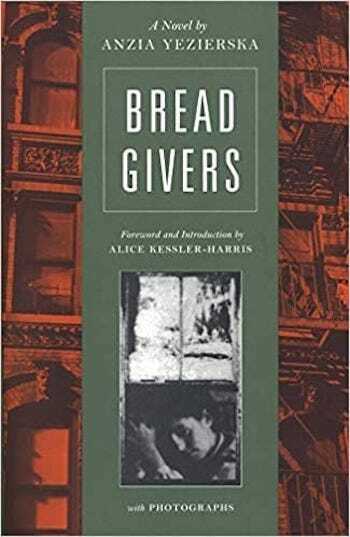
Bread Givers by Anzia Yezierska (1880 – 1970) is the best-known novel by a writer whose work reflected the Jewish immigrant experience in America of the early 1900s. To set this kind of story down with a female perspective was a rarity in her time, reflecting the author’s chutzpah and determination; yet she was forthright about her struggle to write it.
At the age of ten, in 1890, Yezierska arrived with her family to New York City’s Lower East Side. A product of the immigration wave of the late 1800s, she never quite shed the feeling of being an outsider. Longing to rise above her circumstances, she was hampered by her brittle personality and a measure of self-loathing.
Bread Givers (1925) an autobiographical novel, delves into the well-trodden theme of an immigrant family whose children strain against Old World parents.
The three daughters chafe under their father’s domination. The youngest and feistiest is Sara, oddly nicknamed Blut und Eisen (“Blood and Iron”) from the time she is tiny. She’s a born rebel, fighting for autonomy and seeking self-determination. We can assume that she’s Anzia, through and through. The process of breaking away from her father’s domination is painful. Some of her strivings are awkward and uncomfortable, but she emerges as a person (mostly) in command of her world.
. . . . . . . . . .
More literary happenings of 1925 In the summer of 1925, Katharine Sergeant Angell walked into the offices of The New Yorker, then a fledgling magazine, and was hired. Over the next thirty-six years, she would become a powerhouse editor who transformed the publication and made many literary stars. She married another New Yorker star, E.B. White, after which she went by the name of Katharine White.
In the summer of 1925, Katharine Sergeant Angell walked into the offices of The New Yorker, then a fledgling magazine, and was hired. Over the next thirty-six years, she would become a powerhouse editor who transformed the publication and made many literary stars. She married another New Yorker star, E.B. White, after which she went by the name of Katharine White.Her greatest contribution was to publish women writers, establishing and nurturing their reputations. They included Janet Flanner, Mary McCarthy, Elizabeth Bishop, Jean Stafford, Nadine Gordimer, Elizabeth Taylor (the English writer, not the actress of the same name), Kay Boyle, and others. The first full biography of Katharine White, The World She Edited, was published last year. Read more about it here .So Big, Edna Ferber ’s 1924 bestseller, won the Pulitzer Prize for the Novel in 1925. No one was more surprised than she was. Gertrude Stein ’s The Making of Americans: Being a History of a Family’s Progress was published, though the author had finished it many years earlier. It was quite a task to find a publisher for it, as it was densely written with the kind of inscrutable language she became known for.March 25, 1925: Flannery O’Connor , known for stories and novels in the Southern Gothic genre, was born in Savannah, Georgia.May 12, 1925: Imagist poet Amy Lowell died of a cerebral hemorrhage; soon after, she was
posthumously awarded the Pulitzer Prize for Poetry, for the collection What’s O’Clock, published the previous year.September 10, 1925: Beloved contemporary poet Mary Oliver was born in Maple Heights, Ohio
The post Literary Centenaries: Classic Fiction by Women Writers from 1925 appeared first on Literary Ladies Guide.
April 27, 2025
How Losing a Poetry Competition Launched Edna St. Vincent Millay’s Career
Edna St. Vincent Millay was just nineteen when she began to compose “Renascence” some time toward the end of 1911. Written at a time of uncertainty about her future, it was a poem about herself, yet it dealt with the common human struggle to find hope when everything seems hopeless.
She had been an outstanding student in her tiny Maine high school, and a star contributor to the popular children’s publication St. Nicholas Magazine. Once she had passed the age limit (eighteen) for submissions, she was left without an outlet for her poetry.
Fighting despair, she grasped that no one could save her but herself. “I must exert every atom of my will and lift myself body and soul — above my situation and my surroundings …”
Fortuitously, Vincent’s mother Cora, a traveling nurse, spotted an issue of Poetry, A Magazine of Verse in a wastebasket near the bed of a sleeping patient. Rescuing it from the trash, she saw an announcement that new poetry was being collection to be titled The Lyric Year. The magazine was sponsoring a contest with three cash prizes — a grand prize of $500, and $250 for the second and third-place winners.
What a difference $500 would make to the family! In today’s money, that equaled about $15,000. Equally important, if Vincent’s poetry was selected, the exposure would be priceless. Cora pleaded with her daughter, who was distracted by her first situationship with a young woman, to buckle down and finish the new poem. Working diligently over several weeks, it ended up at a whopping 214 lines. Vincent titled the poem “Renascence.” It began:
All I could see from where I stood
Was three long mountains and a wood;
I turned and looked another way,
And saw three islands in a bay.
The first few lines sound simple, but as the poem builds, it grows darker and more complex. On a mountaintop modeled on Vincent’s beloved Mount Battie (where the poem is now inscribed on a plaque at the spot that inspired it) the narrator is awed by nature. He or she (it’s never specified) suffers, experiences death, and is buried. After a refreshing rain, the narrator is reborn and is once again able to experience great joy.
Who is this mystery poet?
While sifting through more than ten thousand mostly mediocre poems, Mr. Earle, the Lyric Year contest’s director, was so moved by “Renascence” that he fired off a letter to “E. St. Vincent Millay, Esquire.” “Dear Sir,” it began, for Mr. Earle believed that such a poem could only have come from the pen of a middle-aged man who had seen much of life.
He informed the poet that “Renascence” was accepted for publication. He then added something he shouldn’t have — that he believed it would win the top cash prize. What he didn’t say was that it wasn’t only his decision to make. And in the end, Mr. Earle was outvoted. “Renascence” came in fourth — no award, no cash prize. Vincent was crushed, but what made it worse was that she’d never heard her mother cry so hard.
The first-prize winner was embarrassed by his award. The second and third-prize winners discussed giving Vincent their prize money (though they never did). If anything in the literary world could counted as a scandal, this certainly qualified.
. . . . . . . . . . .
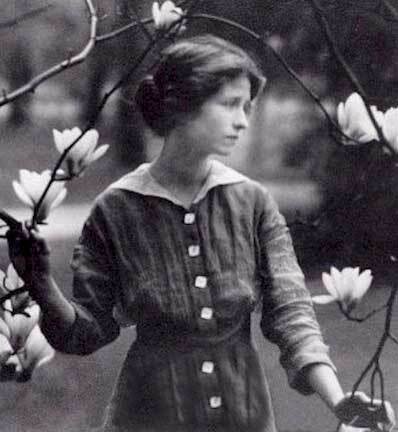
A famous portrait of Vincent taken during her time at Vassar College
. . . . . . . . . . .
And, as it turns out, she won by losing the contest. The hoopla over the loss made her famous overnight — at least, in the literary world and among devoted poetry readers. Everyone believed that “E. Vincent Millay” had been robbed of the honor as well as the prize money. Gradually, it was revealed the creator of this mature, majestic poem, was a young woman not quite out of her teens.
Suddenly, literary magazines offered to publish her work. Now, well-known poets and other writers wrote to her with admiration for “Renascence.” Her replies to her new admirers were so charming that lifelong friendships (some of which later even became romances) were forged.
That summer, Vincent lucked into the opportunity to recite her new poem at the Whitehall Inn, an elegant hotel favored by wealthy visitors to the Maine coast. In her resonant voice, she recited “Renascence” by heart to the rapt audience. Vincent enjoyed the attention immensely. But even better, because of her performances that night, she’d caught the attention of two of the guests who would soon be offering her full scholarships to Vassar and Smith, two prestigious girls’ colleges.
She chose Vassar, mainly due to its easy access to New York City. Twenty-year-old Vincent arrived in New York City already a rising star in the literary world. She was invited to teas with well-known poets and given a reception by famous writers and editors in the city. She was getting paid for poems that were published in magazines. Still, becoming an official adult made her wistful. The day before her twenty-first birthday, she wrote: “Shall be grown-up tomorrow, oh, dear! I loved being twenty. Goodbye to this beautiful year. I somehow feel that twenty-one will be different.” And she was right.
There is lots more to Edna St. Vincent’s life story, but it can’t all be told here. She didn’t live a long life, and it was never uncomplicated but she did live.
. . . . . . . . . . .
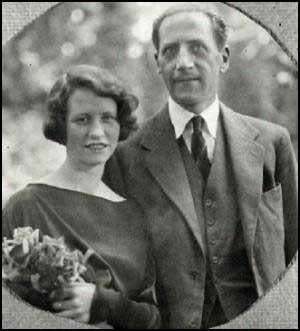
Edna St. Vincent Millay and Eugen Jan Boissevain married in 1923. She and the kindhearted Dutch businessman had a warm, wonderful open marriage.
. . . . . . . . . . .
Renascence by Edna St. Vincent Millay (1912)All I could see from where I stood
Was three long mountains and a wood;
I turned and looked another way,
And saw three islands in a bay.
So with my eyes I traced the line
Of the horizon, thin and fine,
Straight around till I was come
Back to where I’d started from;
And all I saw from where I stood
Was three long mountains and a wood.
Over these things I could not see;
These were the things that bounded me;
And I could touch them with my hand,
Almost, I thought, from where I stand.
And all at once things seemed so small
My breath came short, and scarce at all.
But, sure, the sky is big, I said;
Miles and miles above my head;
So here upon my back I’ll lie
And look my fill into the sky.
And so I looked, and, after all,
The sky was not so very tall.
The sky, I said, must somewhere stop,
And—sure enough!—I see the top!
The sky, I thought, is not so grand;
I ‘most could touch it with my hand!
And reaching up my hand to try,
I screamed to feel it touch the sky.
I screamed, and—lo!—Infinity
Came down and settled over me;
Forced back my scream into my chest,
Bent back my arm upon my breast,
And, pressing of the Undefined
The definition on my mind,
Held up before my eyes a glass
Through which my shrinking sight did pass
Until it seemed I must behold
Immensity made manifold;
Whispered to me a word whose sound
Deafened the air for worlds around,
And brought unmuffled to my ears
The gossiping of friendly spheres,
The creaking of the tented sky,
The ticking of Eternity.
I saw and heard, and knew at last
The How and Why of all things, past,
And present, and forevermore.
The Universe, cleft to the core,
Lay open to my probing sense
That, sick’ning, I would fain pluck thence
But could not,—nay! But needs must suck
At the great wound, and could not pluck
My lips away till I had drawn
All venom out.—Ah, fearful pawn!
For my omniscience paid I toll
In infinite remorse of soul.
All sin was of my sinning, all
Atoning mine, and mine the gall
Of all regret. Mine was the weight
Of every brooded wrong, the hate
That stood behind each envious thrust,
Mine every greed, mine every lust.
And all the while for every grief,
Each suffering, I craved relief
With individual desire,—
Craved all in vain! And felt fierce fire
About a thousand people crawl;
Perished with each,—then mourned for all!
No hurt I did not feel, no death
That was not mine; mine each last breath
That, crying, met an answering cry
From the compassion that was I.
All suffering mine, and mine its rod;
Mine, pity like the pity of God.
Ah, awful weight! Infinity
Pressed down upon the finite Me!
My anguished spirit, like a bird,
Beating against my lips I heard;
Yet lay the weight so close about
There was no room for it without.
And so beneath the weight lay I
And suffered death, but could not die.
Long had I lain thus, craving death,
When quietly the earth beneath
Gave way, and inch by inch, so great
At last had grown the crushing weight,
Into the earth I sank till I
Full six feet under ground did lie,
And sank no more,—there is no weight
Can follow here, however great.
From off my breast I felt it roll,
And as it went my tortured soul
Burst forth and fled in such a gust
That all about me swirled the dust.
Deep in the earth I rested now;
Cool is its hand upon the brow
And soft its breast beneath the head
Of one who is so gladly dead.
And all at once, and over all
The pitying rain began to fall;
I lay and heard each pattering hoof
Upon my lowly, thatched roof,
And seemed to love the sound far more
Than ever I had done before.
For rain it hath a friendly sound
To one who’s six feet underground;
And scarce the friendly voice or face:
A grave is such a quiet place.
The rain, I said, is kind to come
And speak to me in my new home.
I would I were alive again
To kiss the fingers of the rain,
To drink into my eyes the shine
Of every slanting silver line,
To catch the freshened, fragrant breeze
From drenched and dripping apple-trees.
For soon the shower will be done,
And then the broad face of the sun
Will laugh above the rain-soaked earth
Until the world with answering mirth
Shakes joyously, and each round drop
Rolls, twinkling, from its grass-blade top.
How can I bear it; buried here,
While overhead the sky grows clear
And blue again after the storm?
O, multi-colored, multiform,
Beloved beauty over me,
That I shall never, never see
Again! Spring-silver, autumn-gold,
That I shall never more behold!
Sleeping your myriad magics through,
Close-sepulchred away from you!
O God, I cried, give me new birth,
And put me back upon the earth!
Upset each cloud’s gigantic gourd
And let the heavy rain, down-poured
In one big torrent, set me free,
Washing my grave away from me!
I ceased; and through the breathless hush
That answered me, the far-off rush
Of herald wings came whispering
Like music down the vibrant string
Of my ascending prayer, and—crash!
Before the wild wind’s whistling lash
The startled storm-clouds reared on high
And plunged in terror down the sky,
And the big rain in one black wave
Fell from the sky and struck my grave.
know not how such things can be;
I only know there came to me
A fragrance such as never clings
To aught save happy living things;
A sound as of some joyous elf
Singing sweet songs to please himself,
And, through and over everything,
A sense of glad awakening.
The grass, a-tiptoe at my ear,
Whispering to me I could hear;
I felt the rain’s cool finger-tips
Brushed tenderly across my lips,
Laid gently on my sealed sight,
And all at once the heavy night
Fell from my eyes and I could see,—
A drenched and dripping apple-tree,
A last long line of silver rain,
A sky grown clear and blue again.
And as I looked a quickening gust
Of wind blew up to me and thrust
Into my face a miracle
Of orchard-breath, and with the smell,—
I know not how such things can be!—
I breathed my soul back into me.
Ah! Up then from the ground sprang I
And hailed the earth with such a cry
As is not heard save from a man
Who has been dead, and lives again.
About the trees my arms I wound;
Like one gone mad I hugged the ground;
I raised my quivering arms on high;
I laughed and laughed into the sky,
Till at my throat a strangling sob
Caught fiercely, and a great heart-throb
Sent instant tears into my eyes;
O God, I cried, no dark disguise
Can e’er hereafter hide from me
Thou canst not move across the grass
But my quick eyes will see Thee pass,
Nor speak, however silently,
But my hushed voice will answer Thee.
I know the path that tells Thy way
Through the cool eve of every day;
God, I can push the grass apart
And lay my finger on Thy heart!
The world stands out on either side
No wider than the heart is wide;
Above the world is stretched the sky,—
No higher than the soul is high.
The heart can push the sea and land
Farther away on either hand;
The soul can split the sky in two,
And let the face of God shine through.
But East and West will pinch the heart
That can not keep them pushed apart;
And he whose soul is flat—the sky.
. . . . . . . . . . .
You may also like … 12 Iconic Poems by Edna St. Vincent Millay 13 Love Poems by Edna St. Vincent Millay Renascence: and Other Poems (1917) – full textA Few Figs from Thistles: Poems and Sonnets (1920, 1921) – full text Second April (1921) – full text The Ballad of the Harp-Weaver (1922) – full textThe post How Losing a Poetry Competition Launched Edna St. Vincent Millay’s Career appeared first on Literary Ladies Guide.
April 15, 2025
E.L. Konigsburg, Children’s Book Writer who “Dared to Disturb the Universe”
Elaine Lobl Konigsburg, known as E.L. Konigsburg (February 10, 1930–April 19, 2013) was a prolific American writer and illustrator of books for children and middle grade readers.
In 1967, she published her first children’s book, Jennifer, Hecate, Macbeth, William McKinley, and Me, Elizabeth. That same year, her second book, The Mixed-Up Files of Mrs. Basil E. Frankweiler, was also published. (Photo above right by Ron Kunzman)
E.L. Konigsburg’s first book won the 1968 Newbery Honor, and her second won the 1968 Newbery Medal. Though not written at the same time, both were published the same year due to an interesting turn of events.
When school libraries received a substantial increase in funding, an enormous backlog of books was sent to the printing presses. After catching up with this backlog, the publisher printed both of Konigsburg’s books, making it possible for her to have two titles published in the same year.
As it turned out, both titles made the Newbery Medal list: a winner and a runner-up. Konigsburg was the only author to have ever achieved that milestone. In 1997 she won the Newbery for her 13th book, The View from Saturday.
With this award, Konigsburg joined Joseph Krumgold, Lois Lowry, Katherine Paterson, Elizabeth George Speare, and Kate DiCamillo as the only authors to win more than one Newbery. The Newbery Medal is an award granted each year by the American Library Association for the most distinguished American children’s book.
. . . . . . . . . . .
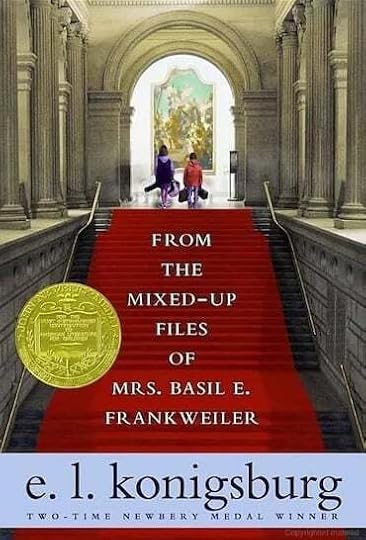
. . . . . . . . . . .
Early life and backgroundElaine Lobl was born in New York on February 10, 1930, to Jewish-Hungarian parents Adolph and Beuhlah Klein Lobl. The family soon moved to Pennsylvania, where Elaine would spend a majority of her growing-up years in small mill towns such as Farrell, a company town that had formed when several steel mills converged in the South Sharon area in the early 20th century.
At its peak in 1920, the population of Farrell was 15,586, but the time the Lobls moved there in the 1940’s, the population was steadily declining. Like many mill towns across the country during the Great Depression, there was less demand for steel; therefore fewer mill jobs. During WWII, production at the mills revved up to produce the steel used for making helmets, aircraft, ammunition, and myriad other products for the war.
The background to Elaine’s teen years was punctuated with a regular blast from industrial whistles and the thudding and scraping of metal against metal as the mills met the war’s demands. The Lobl family made their home above the store they maintained and, thanks to the resurgence of the steel industry, managed fairly well.
As a child, Elaine loved school so much that she felt that getting A’s was what she was best at in life. Because she wasn’t very good at music or sports, she was glad that those were only pass/fail classes, so that she could maintain her A’s. Elaine also loved to read. Her favorite books were the works of Jane Austen, as well as Frances Hodgson Burnett‘s The Secret Garden, and P.L. Travers‘ Mary Poppins. She often read in the bathroom, locking the door to extend her privacy.
Living above the family store, a random sulfuric whiff from the mill tingeing the air, Elaine wished she could find books to read with people like her, like her family – not just books with people who had maids and butlers and sophisticated language.
During the Depression, Elaine’s father lost his job, money was scarce, and the Lobl family moved in with relatives for a time. Elaine wished for books she could relate to. In high school, Elaine practiced her love for drawing and developed a passionate interest in science. She was the editor of the school newspaper and the valedictorian of her class.
Education and a love for science
From 1947 to 1948, Elaine worked as a bookkeeper for the Shenango Valley Provision Company, a meat plant in Sharon, Pennsylvania. There she met the man who would later become her husband, David Konigsburg, the brother of one of the owners. At this job, Elaine managed to earn enough money to pay tuition for her first year at the Carnegie Institute of Technology (now Carnegie Mellon University).
She studied chemistry while working many odd jobs. She also learned how to apply for scholarships and how to receive work-study assistance, so she raise enough funds to pay for school. She graduated with honors with a BS in chemistry in 1952.
After graduation, Elaine married David Konigsburg before starting graduate school at the University of Pittsburgh. David’s work as an industrial psychologist drew the couple to Florida, and Elaine began teaching chemistry at a girls’ private school, where she discovered that she was more interested in what was going on in the students’ heads than inside the test tubes.
. . . . . . . . . . .
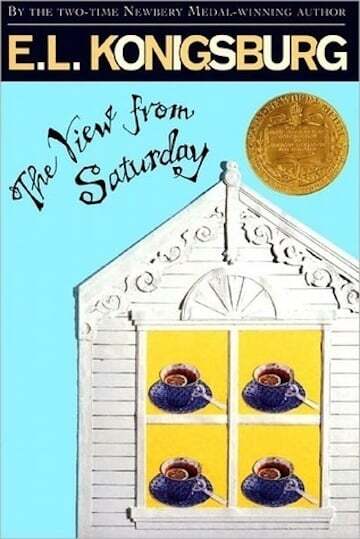
. . . . . . . . . . .
Raising a family and stepping into writingThe Konigburgs had three children, and when the family moved to New York in the early 1960’s, the youngest daughter began school. Konisburg was left to ponder what to do with her newly found free time. She knew she wanted to do something creative and decided to give children’s book writing a try.
She wanted to write books for children around the ages of 8 to 12 because she felt it to be a time when children seek acceptance from their peers – both by being like everyone else and by being different from everyone else.
So, with pencil in hand, she drew her characters, wrote their stories, and found the path through reconciling these struggles faced by children.
Jennifer, Hecate, Macbeth, William McKinley, and Me, Elizabeth, and The Mixed-Up Files of Mrs. Basil E. Frankweiler, were books about people like her own children and characters her own children could relate to. And, as it turned out, not just her own children, but many, children who were able to relate to E.L. Konigsburg’s characters – proven by the continued success of the books.
An inspiring speech: Daring to disturb the universe
In a 1986 talk at Florida Community College at Jacksonville, Konigsburg gave an inspiring presentation full of literary nuggets. In her speech, she included many astute scientific observations, but one of the larger takeaways from the talk was when she stated that those who dare to disturb the universe must first have the courage to disturb the neighborhood.
Though Konigsburg’s speech was punctuated with the creative processes involved in scientific exploration, it was nestled in the fantastic prose from the words of T.S. Eliot‘s famous poem, The Love Song of J. Alfred Prufrock, when he wrote:
I grow old … I grow old …
I shall wear the bottoms of my trousers rolled.
Shall I part my hair behind? Do I dare to eat a peach?
I shall wear white flannel trousers, and walk upon the beach.
It was Konigsburg’s observation that in order to disturb the universe, in order to do the human things that humans should do in their time on earth, they must engage their creative impulse. Konigsburg uses examples of Galileo, Newton, and Einstein to illustrate how people must often struggle against popular thought in order to accomplish what they know to the very core of themselves to be true.
In her speech, Konigsburg melded science and fantasy, blended Einstein’s microscope with Eliot’s meter, with poise and grace and intention, because “… any creative act disturbs the universe,” and disturbing the universe is a uniquely human thing to do, something that, perhaps, humans are supposed to do. Why else would humans be creative? Be it cooking, decorating, mathematical reasoning, arts, crafts, engineering, science, etc. humans are creative and, as logic dictates, should disturb the universe in their time on earth.
Konigsburg, then, was more than a writer and illustrator of award-winning children’s books. She was also an astute philosopher, historian, and speaker, reaching a level of noted genius not all writers achieve.
Konigsburg published a collection of her speeches in 1995, TalkTalk, a children’s book author speaks to grown ups. The topics range from why children’s books matter to where ideas come from to finding the courage to disturb the universe. The book is sprinkled with full-color images and immersed in many deeply expansive scientific and historical observations. A melding of science, philosophy, and art, it’s a true Elaine Lobl Konigsburg original.
E.L. Konigsburg passed away in 2013 at the age of 83. Her last children’s book was published in 2011, marking a forty-four-year span of a writing life. She wrote books that won prestigious awards, were translated into dozens of languages, and made into movies and plays. Her twenty-four books include nineteen novels (some of which she illustrated), two picture books (both illustrated by her), and three nonfiction books.
Contributed by Tami Richards, a history enthusiast and freelance writer living in the Pacific Northwest. More of her work can be found here.
Further reading
E.L. Konigsburg’s complete bibliography Obituary on Publishers Weekly Newbery Award acceptance speechThe post E.L. Konigsburg, Children’s Book Writer who “Dared to Disturb the Universe” appeared first on Literary Ladies Guide.
April 8, 2025
Her Vision, His Genius: How Jo van Gogh-Bonger rescued Vincent van Gogh’s Legacy
Saving Vincent: A Novel of Jo van Gogh (She Writes Press, April 15, 2025) by Joan Fernandez is based on the true story of the fascinating woman who singlehandedly rescued Vincent van Gogh’s artistic legacy (Photo at right, Jo in 1889; photo courtesy of Wikimedia Commons). Here, Joan introduces her novel:
In 1891, timid Jo van Gogh-Bonger lived safely in the background of her art dealer husband Theo’s passionate for selling work by unknown artists, especially his ill-fated, deceased brother Vincent.
When Theo van Gogh died unexpectedly, Jo’s brief happiness was shattered. Her inheritance—hundreds of unsold paintings by Vincent—was worthless. Pressured to move back to her parents’ home, Jo defied tradition, opened a boarding house to raise her infant son alone, and chose to promote Vincent’s art herself.
Her ingenuity and persistence drew the powerful opposition of a Parisian art dealer who vowed to stop her and sink Vincent into obscurity. It would take Jo fifteen years for the world to finally take note of Vincent van Gogh.
. . . . . . . . . . .

Learn more about
Saving Vincent by Joan Fernandez
Saving Vincent
is available on
Bookshop.org
*,
Amazon
*,
and wherever books are sold
. . . . . . . . . . .
As I researched and wrote my story about Jo, I frequently returned to a few questions to deepen and explore her story. Why was Jo so fully invested in promoting Vincent, and how did she guide his works to rise from anonymity into the worldwide adoration we know him today.
How could Jo be so certain that Vincent was an amazing talent when so many art experts said he was not? Here are some fascinating facts about Jo’s background and how she overcame resistance to her late brother-in-law’s artistic vision:
Translated musical concepts to visual appreciation. Jo grew up immersed in music thanks to her industrialist father, Hendrik, who splurged on music lessons for his seven children, and frequently took the family to concerts. In her studies, Jo earned the equivalent of a bachelor’s degree in music. She could draw from this early exposure to music’s abstract concepts when appreciating Van Gogh’s art.
Acquired art knowledge through Theo’s tutelage. After Jo became engaged to Vincent’s brother, Theo van Gogh, they lived apart: Jo in Amsterdam and Theo in Paris. As a result, nearly every day they exchanged letters, discussing several topics but many were on art, reflecting Jo’s keen interest in Theo’s work as an art dealer. Once they married, Jo became a behind-the-scenes confidante to Theo. This was an unofficial apprenticeship for when she had to make decisions on Vincent’s art after Theo’s death, Jo would recall what she had learned from their conversations.
Found personal connection to Vincent through letters. Jo only met Vincent three times in life. A few years after his death, Jo discovered that Theo had hoarded his correspondence with his brother—800+ letters over ten years—and she read them all. The correspondence opened the elusive brother-in-law to her as he shared dreams, hopes, philosophies and commentary on his own art. Vincent’s inner life was revealed to her and she became personally invested in his success instead of relying on Theo’s judgement alone.
. . . . . . . . . . .
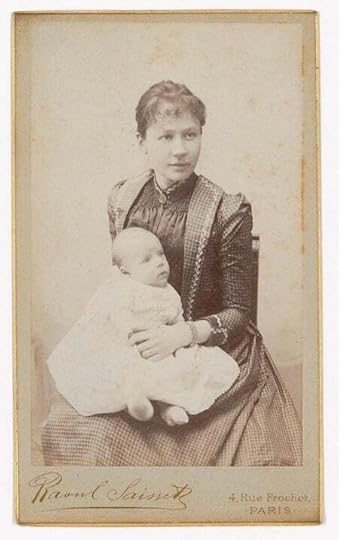
Jo (Johanna) van Gogh-Bonger in 1890 with baby son
Vincent Willem (photo courtesy of Wikimedia Commons)
. . . . . . . . . . .
As Jo faced resistance to Vincent’s art, what did she do to overcome it?
Followed counterintuitive marketing instincts. After Theo’s death, Jo inherited all of Vincent’s artwork. Within a few months, she moved to a small town in the Netherlands. She took ten crates of Vincent Van Gogh paintings with her, despite the objection of Theo’s artist friends. They argued that Paris was the epicenter of art trading. Jo had a different idea. Her first strategy was to approach Dutch art dealers to sell and exhibit his works. Vincent’s artwork was already outside the norm; gaining a foothold among his native Dutch countrymen gave her confidence, and was an initial step to his being accepted elsewhere. The plan worked.
Cultivated Van Gogh fandom. Based on her own experience of appreciating Vincent after reading his letters, Jo began to loan the letters to critics. In the process, this turned them into advocates in the process. She ran excerpts of Van Gogh’s letters (along with drawings) in a series of six articles over several months in a Parisian art magazine. This generated curiosity among the art-loving public, bypassing the art dealers and art critics who were gatekeepers when it came to what the public saw.
Drew upon Vincent’s art to support poverty relief. Caring about the impoverished working class was a core value for Jo. As a little girl, she had been dismayed by the risk and dangers of dock workers employed in the shipping trade where her father worked. Vincent also identified with laborers, feeling more at home with them instead of “money men.” Inspired by this shared empathy, Jo broadened access to Vincent’s art by paying entry fees for the poor and discounting or waiving them for students and workers.
Held to ambitious vision. Jo holds the record for staging the largest museum exhibition of Van Gogh art ever: she refused to take no for an answer when she requested an exhibit at the Stedelijk Museum, Amsterdam’s premier art museum dedicated to modern art. On her third try, the museum directors acquiesced. Over seven weeks (July 15 – Aug 30, 1905), Jo rented out seven galleries to display 484 works, drawing an estimated audience of 4,500 people. This strategy proved successful, marking the breakthrough she had sought. As a result, Vincent’s name was cemented alongside Cezanne and Gauguin as a founder of modern art.
Through a combination of innate artistic sensibility, honed through musical education and an unexpected apprenticeship with her art dealer husband, Jo van Gogh developed a unique understanding of Vincent’s work. Driven by a profound conviction forged through his letters and a resolute belief in his genius, she defied conventional wisdom and followed her own counterintuitive marketing ideas despite resistance from the status quo.
What a joy it has been for me to share how Jo’s unwavering ambition catapulted Van Gogh from obscurity to securing a permanent place for him in history. Jo’s extraordinary vision is an inspiration.
Joan Fernandez is a novelist who brings to light brilliant women’s courageous deeds in history. She is a former senior marketing executive and general partner of the financial powerhouse Edward Jones. In 2018, she retired from a 30+ year career to be a full-time writer. She is a member of the Historical Novel Society, the Author’s Guild, and the Women’s Fiction Writers Association (WFWA). In April 2020, she founded a Historical Fiction affinity group within WFWA that grew from a handful of people to nearly two hundred authors. Her short story, “A Parisian Daughter,” is published in the anthology, Feisty Deeds: Historical Fictions of Daring Women. Saving Vincent, A Novel of Jo van Gogh, (April, 2025) is her debut novel. Find her at JoanFernandez.com.
Further reading
Van Gogh Museum (Amsterdam) The Woman Who Made Vincent van Gogh Johanna van Gogh and Vincent’s LegacyThe post Her Vision, His Genius: How Jo van Gogh-Bonger rescued Vincent van Gogh’s Legacy appeared first on Literary Ladies Guide.
April 1, 2025
Silvina Ocampo, Argentinian Surrealist Writer & Poet
Silvina Ocampo (July 28, 1903 – December 14, 1993) spent most of her life in Buenos Aires, the cosmopolitan capital of Argentina. Born into wealth and privilege, she developed a unique body of work inspired by the avant-garde art and literary movements of her time, including Surrealism and Magical Realism.
Too often, Silvina Ocampo has been mentioned only in relation to her sister, Victoria Ocampo—an intellectual, activist, and publisher; and her husband, Adolfo Bioy Casares, a successful writer and frequent collaborator with Jorge Luis Borges (the pioneering short story writer and translator who brought Spanish-language literature to global prominence).
Ocampo’s work is has been been translated into English more frequently of late. Her short stories reveal astonishing originality, gifts for humor and vivid descriptions, and subtle commentary on social issues of her time.
Childhood, early influences, and art
Silvina Ocampo was born in Buenos Aires to a prominent, wealthy family with aristocratic roots. She was the youngest of six girls, all extensively educated at home by tutors. From an early age, Ocampo spoke and eventually wrote in Spanish, French, and English.
Ocampo’s knowledge of English gave her access to classic American writers, including Emily Dickinson, Herman Melville, and Edgar Allan Poe—all of whom she would later translate into Spanish. Like Poe, many of her later poems and stories feature foreboding atmospheres, unusual deaths for her characters, and sly commentary on the moral hypocrisy of the bourgeoisie.
While growing up, Ocampo and her large family relocated to San Isidoro in the summers, taking up residence in a picturesque villa inspired by European architecture. Years later, Victoria moved in permanently and hosted some of the most influential artistic and literary personages of the 20th century. Ocampo later wrote that her childhood ended after Victoria married and another sister died unexpectedly: “Children have their own hell.”
In her stories, Ocampo rarely described women as naturally maternal or children as charming and innocent. Mothers are often absent and ambivalent; children sense danger close at hand in their sheltered world. In her story “The Prayer,” Ocampo makes this observation: “Children’s crimes are dangerous. Children use any means to reach their ends. They study dictionaries. Nothing gets by them. They know everything.”
When Victoria reviewed her sister’s first story collection, Forgotten Journey, she wrote: “Silvina Ocampo’s stories are memories masked by dreams; dreams of the kind we dream with our eyes open. The friendship or enmity of inanimate things – which cease to be – populate these stories as they populated our childhood or as they populate the lives of savage tribes.”
At the tender age of five, Ocampo made the long journey from Argentina to Paris by ocean liner, and she returned to study art in 1920 when she was seventeen. She studied painting with Giorgio de Chirico and Férnand Leger, both early practitioners of Surrealism. Upon her return to Buenos Aires, she continued painting and frequently participated in exhibitions.
In his preface to Ocampo’s short story collection Leopoldina’s Dream, Borges noted that her artistic skills influenced her writing. “Like Rossetti and Blake, Silvina has come to poetry by the luminous paths of drawing and painting,” he wrote, “and the immediacy and certainty of the visual image persist in her written pages.”
. . . . . . . . . .
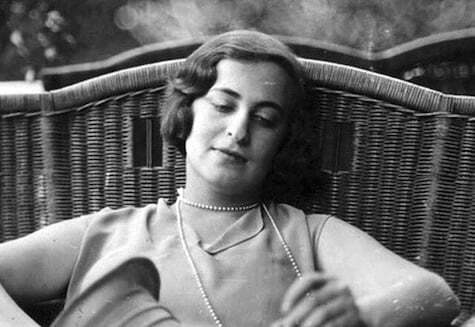
Silvina in the 1930s (photo courtesy of Wikmedia Commons)
. . . . . . . . . .
In 1931, Victoria founded the literary magazine Sur, which, until 1992, published articles by leading writers, philosophers, and intellectuals. Victoria was her sister’s first publisher, and after the latter made her literary debut in Sur, she decided to devote her life to writing.
Ocampo met the aspiring author Adolfo Bioy Casares in 1934, when she was thirty-one and he was twenty. When they married in 1940, they shocked both their families and the bourgeoisie society. Casares was devoted to his wife’s writing and equally admired his sister-in-law’s accomplishments as a publisher and intellectual.
Casares’ support of his wife’s career and their age difference weren’t the only unusual factors of their marriage. He was frequently unfaithful and fathered at least two children by other women. Ocampo adopted his daughter Marta and raised her as her own, and Casares’ extramarital son Fabián was later awarded the right to the estates of both his father and Ocampo.
In her only novel, The Promise, Ocampo wrote: “What is falling in love, anyway? Letting go of disgust, of fear, letting go of everything.” Her writing reveals a hyperawareness that men in Latin American society got away with far more misbehavior than women ever could. Perhaps rejecting societal expectations for marriage was something else Ocampo let go of to remain with a man who took her writing seriously. Casares always returned to Ocampo after his affairs, and they remained married for fifty-three years.
One must read Ocampo’s stories carefully to discern her heroines chafing at the rules that don’t apply to the men in their lives, and how emotional repression and internalized misogyny often lead to acts of violence. Her stories reveal a dedication to depicting the interior monologues of her female characters — often with a shocking disregard for social mores and the intensely Catholic, patriarchal society that foreshadowed that foreshadows the novels of Ukrainian-born Brazilian Clarice Lispector and the bestselling Chilean-American writer Isabel Allende.
. . . . . . . . . .
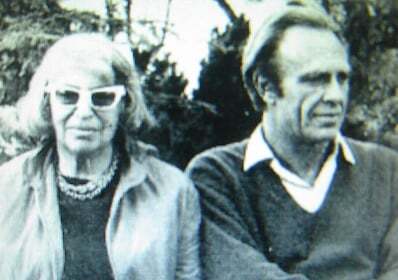
Silvina with Bioy Casares, date unknown
(photo courtesy of Wikmedia Commons)
. . . . . . . . . .
Jorge Luis Borges was often published in Sur, and throughout his celebrated career he maintained close friendships with Ocampo, her husband Casares, and Victoria. Between the four of them, they spoke some ten languages. Borges was renowned for his love of Old English and Norse. They critiqued one another’s works, and wrote prefaces for and reviews for each other.
One of their most significant joint projects was Antologia de la literatura fantástica, published in 1940, later translated as The Book of Fantasy It was jointly edited by Ocampo, Borges, and Casares. They selected some eighty stories by familiar writers including Lewis Carroll and James Joyce, as well as obscure authors spanning ancient China and Imperial Rome. Trailblazing science fiction and fantasy writer Ursula K. Le Guin admired the collection and wrote a foreword for the English translation in 1988.
In 1946, Ocampo and her husband co-wrote a subversive detective story that brilliantly broke all the conventions of the genre, titled Los que aman, odian, which was translated in 2013 as Where There’s Love, There’s Hate. The main character is Humberto Huberman, a name strikingly reminiscent of Humbert Humbert, the antihero of Vladimir Nabokov’s infamous novel Lolita, published nine years later. Both characters act as unreliable narrators in their respective stories.
In addition to her numerous translations of foreign literature into Spanish and her poetry, which Borges greatly admired, Ocampo diligently revised her work with the discerning eye of both an author and an artist. Despite her extensive literary output spanning nearly six decades, only a small fraction has been translated into English. Ocampo wrote eloquently about the importance of writing:
“When you write everything is possible, even the very opposite of what you are. I write so that other people can discover what they should love, and sometimes so they discover what I love. I write in order not to forget what is most important in the world: friendship and love, wisdom and art—a way of living without dying, a way of death without dying. On paper, something of us remains, our soul holds onto something in our lives: something more important than the human voice, which changes with health, luck, muteness, and, finally, with age.”
. . . . . . . . . .
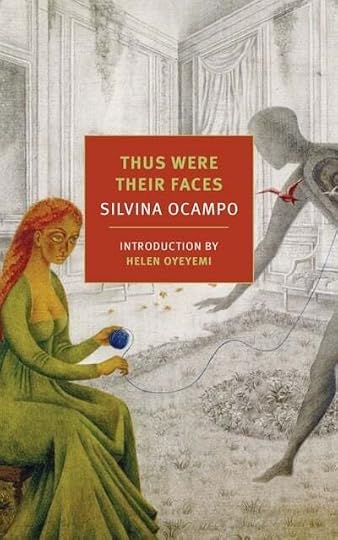
. . . . . . . . . .
Short stories, and a novel 25 years in the makingWith the eye of a painter, even in her briefest stories Ocampo takes time to vividly describe the Argentinian scenery in her tales: grim ancestral portraits and spiral staircases in rotting mansions; flamingoes, llamas, and nights “smelling of mint and rain”; groves of eucalyptus, palm, and rubber trees alongside fields of white carnations and orange gladioli.
Amid all the natural beauty in her tales, terror and cruelty hover nearby. The lingering effects of colonialism are present in several of her stories, when fair-skinned and blonde Argentinian women are treated with more respect than pueblos, or indigenous women, and privileged young men are allowed to use various substances, and beat their pets and servants without consequences.
In 1982, Ocampo wrote in a letter to a friend: “I don’t like conventions, that a novel needs to have an ending, for example.” Widely read in multiple languages, along with her astonishing literary connections, she was fully aware of standard literary conventions and traditions. However, she was as determined to break rules in her novel, as she did in her short stories.
Ocampo revised her only novel, The Promise, over a span of twenty-five years, never explicitly stating that she considered her book finished. She revised it most assiduously from 1988–89, after receiving the diagnosis of Alzheimer’s disease. In many of her short stories, time is rarely linear but rather something that an author can fold, wrinkle, or smooth at will. The same is true of The Promise.
Like Scheherazade in One Thousand and One Nights, Ocampo’s nameless heroine is acutely aware of her hypnotic storytelling powers: “I told stories to death so that it would save my life.” For the duration of the novel, the heroine is stranded in the ocean and memories of her life flood back to her, and it is not revealed how many of the narrator’s memories are true or false.
Only rarely does the narrator comment on the ocean in which she is slowly drowning, such as observations of flying fish, or pondering if mermaids exist. “Horrible, beautiful, divine?” she asks herself. In this eerie tale, the narrator’s descriptions of the sea around her resemble staccato notes in a piece of music that make sense only to the conductor.
Echoing her earlier collaboration with her husband, a murder mystery is woven through The Promise, but isn’t as essential to the plot as it is to revealing glimpses into the character’s personality and motivations. Like in her stories, Ocampo is less interested in Realism than in chiseling away at the absurdity of reality. She wields elements of Surrealism, Magical Realism, and 19th-century Gothic literature with the self-assurance of a master.
“I don’t have a life of my own; I have only feelings,” boldly states her narrator at the beginning of the novel. “My experiences were never important—not during the course of my life nor even on the threshold of death. Instead, the lives of others have become mine.”
. . . . . . . . . .
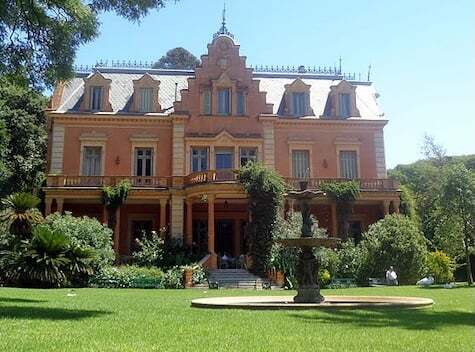
Villa Ocampo in San Isidro
. . . . . . . . . .
In her short stories and The Promise, Ocampo often writes movingly of older women, who “always look like they’re in disguise.” She died on December 14, 1993 at the age of ninety after a three-year decline from Alzheimer’s disease. She was buried in her family’s crypt. Casares was laid beside her after his death six years later.
The Ocampo family home was bequeathed by Victoria to UNESCO in 1973, and Villa Ocampo was fully restored in 2003. It is now open to the public as a cultural center. Among the resplendent home’s many attractions are the high-ceilinged music room, with its grand piano, where Igor Stravinsky and Arthur Rubinstein played. The extraordinary library, featuring some 12,000 books, many of which are signed by the greatest authors of the 20th century.
The Hesburgh Libraries at the University of Notre Dame houses an extensive collection of Ocampo’s writings, including “first editions of her short story publications, poetry collections and collaborative works,” and an undated diary, with a section that “tells the story of two intimate, female friends as they travel to Paris in search of adventure.”
In 1979, her literary oeuvre was denied Argentina’s National Prize for Literature because the judges deemed it “demasiado crueles”—too cruel. Victoria had been nominated twice for the Nobel Prize in Literature in 1970 and 1974, both times losing to male authors. On the latter occasion, Victoria was one of nine nominated women out of more than one hundred writers, illustrating the vast gulf that women writers faced at the time.
In her lifetime, Ocampo witnessed Borges’ work translated into European languages and English, while her own body of published work received little attention outside of Argentina. In addition, it was often unfavorably compared to the work of Borges. Victoria, Casares, and Borges championed her work; the latter wrote: “Silvina Ocampo is one of our best writers. Her stories have no equal in our literature.”
The Cuban-born Italian writer and journalist Italo Calvino also admired Ocampo: “I don’t know of another writer who better captures the magic inside everyday rituals, the forbidden or hidden face that our mirrors don’t show us.”
Ocampo’s work has being increasingly translated in the 21st century. In 2015, the New York Review of Books Classics published a collection of her poetry as well as Thus Were Their Faces, a collection of short stories. In 2019, City Lights Books published Ocampo’s only novel, The Promise, and Forgotten Journey, her debut collection of short stories first published in 1937.
When The Promise and Forgotten Journey were translated, John Freeman provided a glowing review. “Year after year, more of the great Argentinian writer Silvina Ocampo is restored to us, like the lost work of a luminously dark seer … Lusciously strange, uncompromising, yet balanced and precise, there has never been another voice like hers.”
Ocampo published eleven collections of poetry during her lifetime, but only one has been translated into English—Silvina Ocampo, published by New York Review Books in 2015.
She frequently contributed to children’s story collections and literary anthologies. Still, arguably her most famous—and, as of this writing, the only one translated into English—is Antología de la literatura fantástica (1940), on which she collaborated with Casares and Borges, and which was translated as The Book of Fantasy in 1988.
At one point in The Promise, the narrator exclaims, “If I die before I finish what I’m writing, no one will remember me, not even the person I loved most in the world.” Was this fear Ocampo’s own? Perhaps it haunts every writer, but in her case, she need not have feared.
Thirty years after Silvina Ocampo’s death, there is growing interest in her finely crafted, unsettling tales. For centuries, South America has been renowned for its gold. Today, the testimonies and literary contributions of its women are being unearthed, and their vibrant words shine far brighter than any metal.
Contributed by Katharine Armbrester, a 2022 graduate of the MFA creative writing program at the Mississippi University for Women. She is a devotee of Flannery O’Connor and Margaret Atwood, and loves periodicals, history, and writing.
Further Reading and SourcesNovellas and Novels
Los que aman, odian with Adolfo Bioy Casares (1946,translated in 2013 as Where There’s Love, There’s Hate)La torre sin fin (2007, translated in 2010 as The Topless Tower)La promesa (2011, translated in 2019 as The Promise)
Short Story Collections
Forgotten Journey (1937, translated in 2019)Leopoldina’s Dream (1988), revised and expanded by New York Review of Booksin 2015 as Thus Were Their Faces
More information
John Freeman’s reviews of The Promise and Forgotten Journey ,Los Angeles Review of BooksArticle about the publication of The Promise and Forgotten Journey for NPR UNESCO site dedicated to Villa Ocampo University of Notre Dame Hesburgh Libraries Silvina Ocampo collectionThe post Silvina Ocampo, Argentinian Surrealist Writer & Poet appeared first on Literary Ladies Guide.



